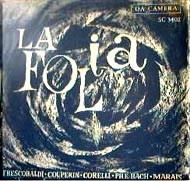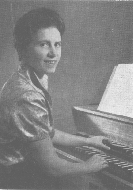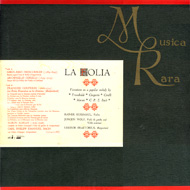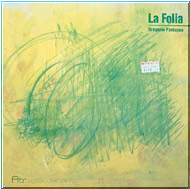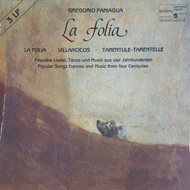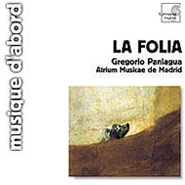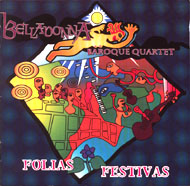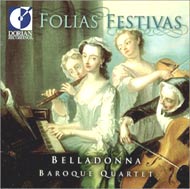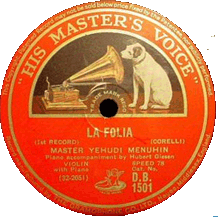 |
Best recordings as introduction |
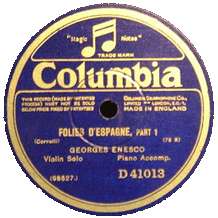 |
Thematical music is hardly recorded groupwise. So you have to buy all the other tracks as well just for that single Folia included. he only well-known exception for a long time was the Folia-recording of Gregorio Paniagua released back in 1982. This recording inspired modern Folia-composers because they refer to this recording or at least the approach of it as mentioned in the slipcase. Lately La Folia seems to gain popularity because from 1998 on there were more discs released completely devoted to Folias. A nice starting point for a concise discography as an introduction to the Folia theme for the interested reader not that familiar with the music itself.
The quality of performance is not that much taken into account, since this is rather arbitrary. For beginners the Folia-variations of Corelli (lead by violin) and Marais (lead by viola da gamba), both from the Baroque era, are recommended since they are generally considered to be the most famous Folias. For people interested in guitar music the disc of Luigi Attademo is recommended where all variations (47) are nicely indexed.
A detailed discography can be found in the chapter of composers (a-z).
|
Praetorius, Lisedore (harpsichord), Kussmaul, Rainer (violin), Wolf, Jurgen (viola da gamba and cello)
released c. 1950 (mono) total duration 43'37" |
Praetorius, Lisedore (harpsichord), Kussmaul, Rainer (violin), Wolf, Jurgen (viola da gamba and cello)
re-released 1967 (mono) total duration 43'37" |
This is the first compilation of later Folias as far as I know. A mixture of later Folias (C.P.E. Bach, Corelli, Marais) and two non-folias: the Frescobaldi (Partita sopra l'aria di Folia) which is despite the title a completely different dance namely the Fedele and the F. Couperin (Les Folies Françaises ou les Dominos). Unfortunately only half of all variations by Marais' Folies d'Espagne are played. No dates of recording-sessions or lp-release but I guess it can be dated around 1950 because the word 'stereo' was not invented yet but the performer Liselore Praetorius was teaching harpsichord at the Staatlichen Musikhochschule in Stuttgart from 1946 till the recording was released according to the text on the back of the LP.
Harmut Broszinski wrote for the backside of the cover of the Da Camera vinyl:
Der Titel "La Folia" wird heute wie
selbstverständlich mit der "berühmtesten aller
Sarabandenmelodien" identifiziert, doch gilt es einen kleinen Exkurs in
die Musikwissenschaft: wir wollen einmal der Entstehung des Namens, zum
anderen den Ursprüngen und der Entwicklung der Musik nachgehen,
die wir mit "La Folia" bezeichnen. Hiermit ist bereits angedeutet, dass
es sich um zwei verschiedene Dinge handelt. Zunächts zum Namen:
Seit dem frühen 15. Jh ist ein portugiesischer Tanz belegbar, der
anlässlich von Fruchtbarkeitszeremonien getanzt wurde. Nach heute
hat er seine Parallelen im Ritual des "Wilden Mannes" zu Basel, im
englischen "Morrisdance", auf den Balearen usf. In die höfische
Kultur des 14.-17. Jh. ging er als "Moresca" ein - eine sich u.a. in
Galliarden- und Giguenform bewegende Musik. Der alte portugiesische
Tanz der Morrisdance, und die Moresca hatten gemeinsam, dass
Männer in weiblicher Verkleidung, dass der "Morris" (Mohr), der
"fool" (Narr) oft hoch zu Ross, das will heissen auf den Schultern
ihrer Mittänzer, umhergetragen wurden. In Deutschland tanzte man
ihn nach den bekannten Melodien "Der schwarze Knab" (morris) und
"Narrenweis" (fool). Da sich jedoch die höfische Kultur inzwischen
von den Ursprüngen des Tanzes entfernt hatte, kam es zu
sonderbaren Missdeutungen. So ritt gelegentlich von Turnieren
("folla"), während die Banketthülle ("follia") mit
grünen Zweigen ("feuilles") geschmückt wurde, ein "morris"
auf einem Einhorn daher, das Rotwein ausschenkte. - Die mehr oder
weniger improvisierten Gesänge, die einen Teil dieser
Fruchtbarkeitszeremonien in Spanien und Portugal darstellten, drangen
in dramatische Schöpfungen des 15.-17. Jh. ein, so wie ja auch
eine Moresca am Schluss von Monteverdis "Orfeo" zu finden ist. Um 1500
taucht für diese Gesänge in Spanien der Name "folias" auf.
Was allerdings der Anlass zu dieser Namensgebung ist, ob die
"Narrheit", die "folla", die "follia" oder die "feuilles" (s.o.),
bleibe dahingestellt.
So wie dieser Tanz hat auch die Musik, die später den Namen
"Folia" übernahm, ihren Ursprung auf der Iberischen Halbinsel.
Zuerst lässt sie sich in einigen Stücken des "Cancionero de
Palacia" von Juan del Encina (1494) im Zusammenhang mit dramatischen
Werken, wenn auch zunächst in rudimentärer Form, nachweisen.
Wesentlich ist, dass weniger die "Melodie" als der Bass bzw. die
Harmoniefolge den Vorrang hat. Im Gegensatz zu der vollentwickelten
"klassischen" Form, die als Doppelzeile 16 Töne aufweist, bauen
fast alle dieser frühen Stücke auf einer 8-tönigen,
meist mit der Dominante endenden Bassstimme auf. Völlig fehlt noch
die rhythmische Bindung, es werden oftmals Mittelteile und
Wiederholungen einzelner Töne eingeschoben, wie es der text, zu
dem diese Musik geschrieben wurde, erforderte.
Auch in Italien lassen sie zu der Zeit ähnliche Formen nachweisen.
Der "Folia"-Bass hat enge Verwandtschaft mit Vertonungen von " terza
rima" - Texten der italienischen Gesellschaftsmusik und den ostinaten
Bassbildungen der Tänze "Romanesca" und "Passamezzo Antico", doch
sind diese, vielleicht in Anlehnung an die "Bassadanza" des 15.Jh.,
rhythmisch straff gebunden. Erst im frühen 17. Jh., nachdem sich
die Folia-Formel dem "Folia"-Tanz angepasst und dessen Namen
übernommen hatte, wird auch sie rhythmisiert. Wo sich "Romanesca"
und "Passamezzo" mit Vokalformen verbinden, wie in den englischen
"Ballad-tunes" oder etwa im "blues", sind auch sie zwar elastischer,
doch die "Folia" war seit eh und je der Gefahr des "Zersingens" mehr
ausgesetzt. Anlass dafür gaben wahrscheinlich die stereotyp sich
wie im Kreise drehende Musik, die förmlich nach Veränderung
schrie und die Assoziation Narrheit ("folie") - freies Spiel der
Phantasie.
Frescobaldi, der mit den "Riprese" seiner 6 Variationen noch dem
frühen Typus angehört, verwendet die Töne 9-16 des
Basses, variiert jedoch zwei von ihnen. Alessandro Scarlatti benutzt
nur die erste Zeile, die mit der Dominante endigt und baut auf ihnen 21
Variationen auf. Die endgültige "klassische" Form, doppelzeilig
und metrisch genau festgelegt, bildet sich allmählich bei den
grossen spanischen Gitarristen, wie Colonna, Sanseverino uns. im ersten
Viertel des 17. Jh. heraus. So kann Cervantes 1613 die "Folia" in einem
Atem mit der Ciaconna und der Sarabanda nennen.
In dieser Gitarrenliteratur kommt es weniger auf die genaue Fixierung
der "Melodie" an, da diese dem Spieler zur improvisation
überlassen wurde, als auf die Harmoniefolge, wabei der Bass oft
aus spieltechnischen Gründen variiert wurde.
Ihren Höhepunkt erreichten die "Folia"-Bearbeitungen Stücken
des Cancionero de Palacio" von Juan del Encina (1494) im Zusammenhang
schufen damals brillante Variationenketten für Tasten- und
Streichinstrumente. Couperin führte diese grosse Tradition fort,
indem er in seinem "Les Folies Françaises ou les Dominos" getreu
seiner brillanten Kleinkunst, die zwölf Couplets, die auf dem
16-tönigen Bass aufbauen, menschliche Eigenschaften, wie "La
Pudeur" oder "L'Ardeur" zeichnen lässt. Ph. E. Bachs
Variationenwerk beschliesst den Reigen der barocken
"Folia"-Bearbeitungen, doch bus zu Liszt (Spanische Rhapsodie, 1863)
und Rachmaninoff (1932) regt die unscheinbare Melodie die Komponisten
zu immer neuer Ausseinandersetzung mit ihrer zwingenden Magie an.
LA FOLIA: Variations on a popular melody by Frescobaldi—Couperin—Corelli—Marais—C.P.E.Bach.
The basis of traditional jazz is a traditional folk melody, upon which the musicians elaborate as the mood
takes them. In the negro jazz days of the nineteen-twenties, most of what are now known to have been the best
jazz improvisators could not read music anyway, and the folk tunes used as their basic melodies were passed on
by ear rather than by pen or print. Later on the jazz variations began to be written down, though they were
still based on well known folk melodies.
During the 17th and 18th Centuries, numerous compositions took the form of variations or sets of variations
on well known traditional melodies. The chorale variation was basically the same too, except that a hymn tune
rather than a popular melody served as the basis.
Perhaps the most well known Barock composition in the form of a popular tune, or Air & Variations, is the set
by J. S. Bach for the keyboard known as the Goldberg Variations (named after the dedicatee). The Air is played
'straight' at the outset, and is then followed by 30 variations on the Air, using every possible rhythmic and
contrapuntal device.
This record presents the Air and Variations idea in another form. LA FOLIA is a tune popular before and right
through the Barock age, it is supposed to have originated in Portugal in the 15th Century. Such was the
continued popularity, and such were the interesting harmonic possibilities of this tune, that a considerable
number of musicians wrote Variations using LA FOLIA as a basis. We have selected a number of these compositions
for this record, thus we present sets of Variations by five different composers from the early 1600's to the
mid-1700's, each using the tune LA FOLIA as the basis.
Not only does this afford a useful introduction to the art of Variation on a popular tune, the Barock
counterpart of traditional jazz, it is also interesting to follow the change in style from the early Barock
through to the early Classical of C.P.E.Bach. Nationally, Italy, France and Germany, with their own individual
styles, are represented.
- Bach, Carl Philipp Emanuel (1714-1788)
- Title: Les Folies d'Espagne
- Performer: Praetorius, Lisedore (harpsichord),
- Duration: 9'05"
- Recording date: not mentioned
- Corelli, Arcangelo (1653-1713)
- Title: Sonate XII (La Follia) für Violine und Generalbass
- Performers: Praetorius, Lisedore (harpsichord), Kussmaul, Rainer (violin), Wolf, Jurgen (viola da gamba and cello)
- Duration: 12'27"
- Recording date: not mentioned
- Marais, Marin (1656-1728)
- Title: Couplets de Folies d'Espagne
- Performers: Praetorius, Lisedore (harpsichord), Wolf, Jurgen (viola da gamba and cello)
- Duration: 7'51"
- Recording date: not mentioned
Les Folies d'Espagne by Lisedore Praetorius
|
|
'La Folia de la Spagna' Gregorio Paniagua
reissue released unknown year ATR put out an earlier non-180 gram total duration 44'20" |
Gregorio Paniagua
HM 1050 released 1982 total duration 44'20" |
Gregorio Paniagua
(3 lp-set) reissue released total duration 44'20" |
Gregorio Paniagua
series Musique d'Abord released 2006 total duration 44'20" |
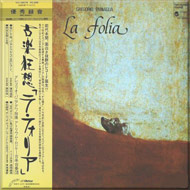 |
Japanese Vinyl Paniagua |
Fragment of this famous recording
|
La Folia is a disc with lots of relatively unknown early and later Folias in fantasy-arrangements including sitar, crumhorns and hurdy-gurdy. The Folias are crossed by harmony lessons of Hindou and fragments of Indian ragas. No familiar instrumentation for the Corelli or Marais, but all instruments are well played and the instrumentation occasionally gives a refined medieval flavour to the 'later' Folia theme which is unique compared to all other interpretations of the Folia-theme on other discs.
There is a huge difference between the documentation of the LP- and the cd-version. In both versions the history of the Folia as musical phenomenon is explained accurately but as the LP is a first class collectors-item because in a majestic table all the instruments and sources are explained and the recording quality is extremely high, the omission of this detailled table is rather painful in the slipcase of de cd-version because the sources are hard to identify in these fantasy-arrangements.
Here is the most important part for these pages of that table: the sources used for the arrangements of Paniagua.
LA FOLIA DE LA SPAGNA side A recorded
1980 |
|||
| Title of the Follias by Paniagua | Sources used as inspiration | ||
| 01 | FOLLIAS: | FONS VITAE | Atrium Musicae de Madrid. "Sunt lacrimae rerum et follias Hispanorum" |
| DEMENTIA PRAECOX ANGELORUM | Follias de Españia. Mss. Bibl. Nac. Madrid M 2810 (once variaciones). Anónimos. Musica para Salterio, Clave y Orquesta. folios 11, 12,13 y 14 | ||
| SUPRA SOLFAMIREVT | Atrium Musicae de Madrid et Leçon de solfège hindou, Benares. India | ||
| 02 | FOLLIAS | EXTRAVAGANS | Cuatro Folias anónimas. "Ramillete de flores" Bibl. Nac. Madrid Mss. 6001 folios 272, 273. Anno, 1593 |
| LAUREA MINIMA | Aquarelle de très petite dimension, exécutée avec une délicatesse particulière | ||
| FOLLIAS: IN VITRO | Rêverie fluorescente. Notre Dame des Anges. Lurs. Basses-Alpes | ||
| 03 | FOLLIAS | ORATIO PRO-FOLIA | Adorámoste Senor Iesuxristo. Fco. de la Torre. XVe sièc. Canc. Mus. de Palacio. Bibl. Real. Madrid |
| FAMA VOLAT | Indianapollis. Eau de source, chose qui se produit naturellement, du pétrole | ||
| CITRUS - HESPERIDES | Hermita de Nuestra Señiora del Pelotazo. Mar Caribe. Anc. fr. 99 la Valière | ||
| 04 | FOLLIAS: | PRINCIPALIS - FERMESCENS (Nihil ad me attinet) | "Huerto Ameno de varias flores de mússica" anno 1709. Obras recopiladas por Fray Antonio Martin Coll, Organista de S. Diego de Alcalá y de S. Francisco en Madrid. Bibl. Nac. Madrid Mss. 1360. "Las Folias" folios 212-215 |
| INDICA EXACTA | Raga : Yaman (Alap) Musique Classique traditionnelle hindoue | ||
| ADVERSO FLUMINE | Petite angoisse et anxiété antimusicologue. Oxygène & Ozone. 1980 Cercedilla | ||
| 05 | FOLLIAS: | PARSIMONIA ARISTOCRACIAE | Libro de Musica de Clavicimbalo del Sr. Dn. Francisco de Tejada. Sevilla 1721 Mss. 815. fols. 72-73. Madrid Bibl. Nac. "Folias graves" |
| Ministère des travaux publics. Ramassage de coquelicots. France | |||
LA FOLIA DE LA SPAGNA side B recorded
1981 |
|||
| Title of the Follias by Paniagua | Sources used as inspiration | ||
| 01 | FOLLIAS: | SUBTILIS | Jean-Francois Pontefract. harmonia mundi, 04870 Saint-Michel de Provence |
| DE PROFUNDIS - EXTRA MUROS | Cancionero Sephardita "Judeo-Espaflol traditional : El rey por muntha madruga" | ||
| 02 | FOLLIAS: | VULGARIS - SINE POPULI NOTIONE | Folias de España. Gaspar Sanz. Instruccion de Musica. Caesaraugusta 1674 |
| VAGULA ET BLANDULA | Nuit d'Espagne pendant laquelle on ne dort pas. Toledo XVe siècle | ||
| 03 | FOLLIAS: | NORDICA ET DESOLATA | Variations "d'après la Folia : Doen Daphne d'Over schoone maeght" Jr. Jacob van Eyck. "Der fluyten lust hoff" Amsterdam 1646 |
| AUREA MEDIOCRITAS | Improvisatione ad mente : Country dance XVIIIe siècle d'après John Playford. London "The englishdancing master" anno 1651 | ||
| 04 | FOLLIAS: | NOBILISSIMA | Bernardo Pasquini (1637-1710), Partite sopra la aria della Folia da Espagna |
| DEGRADANS ET CORRUPTAE | Cajita de Musica desafinada. El Rastro. Madrid vers 1850 | ||
| 05 | FOLLIAS: | DE PASTORIBUS | Folia "Rodrigo Martines" Anónimo. XVe s. Canc. Mus. de Palacio no 12. Bibl. Real. Madrid |
| MATHEMATICA DIES IRAE | Sequentia "Missa pro defunctis" atrib. Tomas de Celano. Liber usualis | ||
| CREPUSCULARIS | "Muchos van de amor heridos" Anónimo. Canc. Mus. de Palacio no 92. Bibl. Real. Madrid | ||
| SINE NOMINE | Improvisatio ad libitum. "Notre Dame des Angles immortelles" | ||
| TRISTIS EST ANIMA MEA | "Dime triste coracon" folia. Francisco de la Torre. Can. Bibl. Colombina Sevilla XVe s. | ||
| EQUITES FORTIS ARMATURAE | "Sefiora de fermosura" folia. Juan dell Enzina. Canc. Mus. Palacio no 81 Bibl. Real. | ||
| AUDACES FORTUNA JUVAT | "Pues que ya nunca os veis" Juan dell Enzina. Canc. Mus. Placio no 271 Bibl. Real. | ||
| SINE PRAEPUTIUM | Improvisation sur un thème de Jazz : La Boussole et rose des vents | ||
| ECCLESIASTICA | Fabordon "Arte de taner Fantasia" Fray Thomas de Sta. Maria Madrid 1565 | ||
| 06 | FOLLIAS: | THEATRALIS ET HIPOCRITAE | Folies d'Espagne. Bethune le Cadet. M. Monien. Pièces en tablature d'angélique. Paris 1681 |
| RURALIS | Country dance "La nouveauté a toujours un charme particulier" | ||
| ALTER INDICA PERFECTA | Raga : Yaman. Musique classique traditionnelle hindove. Benares 1979 | ||
| 07 | FOLLIAS | DE TOLERENTIA AETHEREA | Adagio "La Follia" Arcangelo Corelli (1653-1713) op. 5 no 12. PubI. pour flûte douce : John Walsh. London 1702 |
| FUGA FICTA ET CARRUS TRIUMPHALIS | Sonata "Carrioches" dedicada al Exemo. Alcalde de S. Ildefonso de la Granja : Sr. Dr. Erik Claveria. Agosto de 1979. Rosalia's Follia's . Archivo particular de Gregorio Paniagua & Beatriz Amo | ||
Below is the list of sources Paniagua didn't use for his recording which gives a lot of information about Folias and which is no part of the slipcase version of the compact disc:
SOURCES NON UTILISEES
"Honce Diferencias de Folias" Mendoza. Mss. 6001 Bibl. Nac. Madrid.
Ramillete de Flores, 1593 - Choreografie, M. Feuillet, Paris 1700. Folie d'Espagne
pour femme. Bibl. Nac. Madrid M 1146/2 - Folias de España. Bibl. Nac.
Madrid. M 1884 - Folias no 22 Arte de Danzar. Pablo Minguet e Yrol (1758). Bibl.
Nac. Madrid. R. 14649 - A. Corelli. Sonata La Follia. Violin y Clave. Opus 5
no 12 - Folias "Poema Harmonico". Francisco Guerau, Madrid 1694. Fol.
51 - Folias "Pensil deleitoso de suabes flores de Musica" Fray A.
Martin Coll. Alcalá de Henares 1707, Mss. B. Nac. no 1358 - Folias "Flores
de Música" Fray A. M. Coll, Alcalá 1708. B.N. Mss. 1359 -
Otras Folias. "Huerto ameno" Fray A.M. Coll, Alcalá 1709. B.N.
Madrid Mss. 1360. Fols 215 v - 217 - "Libro de Cifra Nueva para tecla,
harpa y vihuela" Luys Venegas de Henestrosa, Alcalá de Henares,
1557. Duo "Pues no me quereis hablar" Anon. & "Para quien
crie yo cabellos ?" Antonio de Cabezon - Cancionero Musical de Palacio,
Siglos XV-XVI, Madrid Bibl. Real. sign. 2-1-5 : no 310 : "Meu naranjedo
no ten fruta" Anón. & no 361 : "No puedo apartarme"
Anón. & no 179 : "Si abrá en este baldres" Juan
dell Enzina (1469-1529?) - Ensalada "La Trulla" Cáceres. Bibl.
Central Barcelona M. 588 - "Goigs de Sant Cristófol" Folia
a 4. Mss. siglo XVI. Ayunt. Valencia, texto en catalan anno 1449 - "Tonos
Humanos" B. Nac. Madrid Mss. 1261. Chacona, Folia & Xacara - Folia.
Jácara, para clave. B.N. Madrid, Mss. 1357 - Del grupo de Folias vocales
derivan : Pavanas 1 y II. A. Mudarra "Musica para Vihuela" Sevilla
1546. Folia-sPavanas de E. Valderrábano "Silva de Sirenas"
Valladolid 1547. Pavana, Diego Pisador, Salamanca 1552. (Folia). "Pavana
con su glosa" A. de Cabezón "Libro de Cifra Nueva" Alcalá
de Henares, 1557 - Follias en "Las Ensaladas" Mateo Flecha (1481-1553).
Praha 1581. "Para mi lo querria madre mia" (EI Jubilate). "Venid
presto pecadores" y "Alegria Cavalleros" (El Fuego) - Otras "Follias
d'Espagne" en Bibl. Nac. Madrid M. 811, M. 815, M. 1358, M. 2262, M. 2801
- Follias, Arpa y Guit. "Luz y Norte para caminar por las cifras de la
guitarra españiola" Lucas Ruiz de Ribayas. Añio 1677 - Follias
di Spagna "Sonate di Chitarra Spagnola" A. Carbonchi Fiorentino. B.N.
Madrid M. 3785, Anno 1640 - "La guitarre Royale" de Francisque Corbett.
"Folias d'Espagne". Paris 1671 - Folia di Spagna. L'accademico Coliginoso.
"II Foscarino" "I quatro Libri della Chitarra Spañola"
S. XVII - "Folias mui despacio al estilo de Francia" Santiago de Murcia,
"Resumen de acompañar la parte" Madrid 1714, B. Nac. R. 5048
- Recercadas VII y VIII sobre La Follia. Diego Ortiz Tolledano. "Tratado
de Glosas sobre Clausulas" Roma 1553 - Diferencias de Folias. Iohannis
Cabanilles. Mss, de fines del Siglo XVII, B2. Barcelona. Bibl. de Cataluñia
M. 387 (888). B3. Barna, B. de C. M. 729 (980) - "Folias con 20 diferencias"
Jose Ximenez, S. XVII. Corpus of Early Keyboard Musik. W. Apel & "Antología
de Org. Espanoles" H. Anglés - Tema de Folias, Folias de Santander,
etc. en "Canc. Mus. Pop. Español" Felipe Pedrell. Barcelona
Ed. Boileau 1958 - Folia : "En la cumbre, Madre" Juan Pujol &
Folia : "Cervatilla que corres" Juan Arañes, Canc. Bibl. Canatense.
Siglo XVII - "Les Folies d'Espagne". Tablature pour le Luth (a due
Liuti) Köln 18 Jahrhundert - Folia-Romanesca "Guardame las vacas"
M. Flecha. "La Viuda" S. XVI-XVII - Folia "Si una volta"
Canc. de Olot. Popular-Catalonya, vers 1650 - A. Moser : "Zur Genesis de
Folies d'Espagne", in Af. M. w.I, 1918-19 - O. Gombosi. "Zur Frühgesels
des Folies", in A.M.I. VIII, 1936 - O. Gombosi. "The Cultural and
Folkloristic Background of the Folia" in Papers of the "American Musicological
Society". IV. 194 et. - Works sopra "La Folie d'Espagne" de P.
Nettl "Die Musikgeschichte des Tanzes" 1945 & Opus, J. Ward -
"La Folia historica y la Folia popular canaria" Rev. EI Museo Canario,
Las Palmas 1965 - "La tradicion coral hispánica de la '`Folie d'Espagne"
y sus derivaciones instrumentales" M. Querol. Anuario Mus. Vol. XXI, Barcelona
1968 - "De Musica Libri Septem" Fco. Salinas. Salamanca 1577 - Canc.
de la Sablonara S. XVII - Folia, Jakuba Duran Loriga. Madrid 1980 - "Folias
de España" par: G. Stefani (1622), C. Milanuzzi, Marin Marais, A. Corelli,
d'Anglebert, J.B. Lully, G. Frescobaldi, F. Farinelli, Manetti, A. Vivaldi,
Keiser, Pergolesi, C.P.E. Bach, J.S. Bach, Gétry, Cherubini (L'Hôtellerie
portugaise), Liszt (Rapsodia Española 1863), G. Fauré, C. Nielsen (Mascarade,
1906), Rachmaninov... et cetera.
In 1982 Gregorio Paniagua wrote for the slipcase (only the text in regard to the later Folia is quoted):
At the beginning of the 17th century the dance was
fashionable throughout Europe and, perhaps by being transformed into a
kind of passacaglia or 'ground' which gave it a quiet and even a severe
style, it lost its rapid tempo and its original orgaistic vitality.
This mutation served as the pretext for certain pedants and sages to
attribute to the Folia a different origin than its Hispanic one and to
use it as a basis for their theories on the basso continuo and its
Italian origins.
Nonetheless, all European musicians designated these dances as 'Folies
d'Espagne'. It should be borne in mind that all the time the term
'España' referred to all the countries in the Iberian Peninsula.
Thus we have 'Folies d'Espagne' by G. Stefani (1622), C. Milanuzii,
Corelli, d'Anglebert, Lully, Frescobaldi,
Michel Farinel (Farinelli or Faronel) - who introduced them into
England -, Manetti, Vivaldi, Keiser,
Pergolesi, Johann Sebastian and Carl Philipp Emanuel Bach,
Gréty. Cherubini quoted Corelli's piece in the ouverture to his
L'Hôtellerie Portuggaise' (1798), and the Danish composer, Carl
Nielsen used the theme in his opera 'Maskerade' (1905). Liszt included
it in his 'Rhapsodie Espagnole' (1863).
All the composers in the world who write their own Folia don't keep a
close account of what they are doing. They mature patiently like the
tree that does not haste his sap; They soak up everything and remain
confident in the torments of spring, without anxiety that they might
not know another spring. And spring comes and and a quiet weariness
overcomes them, even if all eternity lay before them.
They can then love their Folia and their solitude; they endure the pain
it causes them and succeed in investing the sound of their complaint
with beauty.
'Klavier Variations on La Follia'
James Bonn
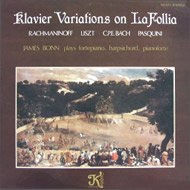 |
released 1982
total duration 46'05"
This is a noteworthy release in more than one way. It was released before the Folia-theme became very popular as a central theme for a recording (the late 1990's and later), the documentation of Maurice Hinson is extremely good and best of all is that four different keyboards are used to give the performances an historical setting. I can imagine that it demands extra technical capabilities of the performer besides the organization of the different instruments for a recording-session, but the results were well worth the effort. You can easily compare the different instruments in their musical setting and the treatment of the Folia-theme within that context, although the performer might not be a virtuoso on all four different instruments. But somehow that disadvantage feels not that important anymore.
Maurice Hinson wrote for the slipcase about the Folia-theme in general (see for his excellent characteristics of the individual pieces at the pages of the composers):
This recording follows the use of the folia, a famous melody of the 17th century, by four composers from four different centuries:
Bernardo Pasquini (1637-1716), C.P.E. Bach (1714-1788), Franz Liszt (1811-1886), and Sergei Rachmaninoff (1873?1943). The folia (follia, follia di Spagna, folies
d'Espagne) was originally an ancient Portuguese dance. Melodies titled folia are on record as early as 1577, and it is upon the bass of one of these
tunes that most folia variations are constructed. Paul Nettl, in his article "Zwei spanische Ostinato?themen", Zeitschrift für Musikwissenschaft, I
(1918-1919), 694-698, shows the appearance of the folia theme still earlier in the lute books of the middle 16th century, but these themes were not specifically
named folies. Some folias, like Alessandro Scarlatti's Variazioni sulla follia di Spagna, utilize only the first half of the bass.
That work includes twenty-nine variations and often involves very noteworthy and original formulae. Other sets are built upon the melody,
as well as the bass, of this ancient dance, but such sets, examples of melodic-harmonic treatment, cannot be regarded as true basso ostinato variations.
The twelfth violin sonata of Arcangelo Corelli (1653-1713) is one of the most celebrated of all folias and is of this type.
Rachmaninoff used this folia in his op.42 "Corelli" Variations.
The Variations sur les folies d'Espagne by Jean Henri d'Anglebert (1628-1691) is the earliest example of the song variation in
France, perhaps the only one except for 18th-century noels. Most of its twenty-two variations remain within the limits of the French style, but a few are
composed according to the formula variation recipe, which d'Anglebert probably received from Italy.
- Bach, Carl
Philippe Emanuel (1714-1788)
Folie d'Espagne performed by James Bonn
Duration: 8'48" direct link to YouTube
© 1982 by James Bonn- Title: 12 Variations auf die Folie d'Espagne (1778)
- Performer: James Bonn (Dulcken fortepiano)
- Duration: 8'48"
- Recording date: not mentioned in the documention
- Liszt, Franz
(1811-1886)
Rhapsody Espagnole performed by James Bonn
Duration: 8'42" direct link to YouTube
© 1982 by James Bonn- Title: Rhapsody Espagnole (1867)
- Performer: James Bonn (Erard piano)
- Duration: 13'12"
- Recording date: not mentioned in the documentation
- Pasquini, Bernardo (1637-1710)
Partite di Follia by James Bonn
Duration: 5'00" direct link to YouTube
© 1982 by James Bonn- Title: Partite di Follia (c.1697)
- Performer: James Bonn (Flemish harpsichord)
- Duration: 5'00"
- Recording date: not mentioned in the documention
- Rachmaninoff,
Sergei (1873-1943)
Variations on a Theme of Corelli by James Bonn
Duration: 19'05" direct link to YouTube
© 1982 by James Bonn- Title: Variations on a Theme of Corelli (1932)
- Performer: James Bonn (Bosendorfer piano)
- Duration: 19'05"
- Recording date: not mentioned in the documentation
'La Folia'
Werner Bärtschi
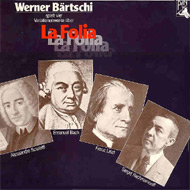 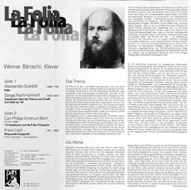 |
released 1983
total duration 48'39"
In 1982 Werner Bärtschi wrote for the slipcase about the Folia-theme:
Die Folia ist ein alter, ursprünglich
portugiesischer Tanz, der durch eine feststehende, in einer einfachen
Bassformel repräsentierte Harmoniefolge charakterisiert wird. Die
darüberliegende Melodie folgte ursprünglich zwar einer
gewissen Grundstruktur, war aber im einzelnen frei, bis Arcangelo
Corelli eine besonders einsprägsame melodische Formuliering der
Folia zum Thema seiner Violinvariationen machte. Der Erfolg seines
Werkes bewirkte, dass vom 18.Jahrhundert an unter Folia normalerweise
diese (ursprünglich nicht von Corelli stammende) Melodie
verstanden wird. Sie representiert bereits den Typus der
'Themenmelodie' im klassisch-romantischen Sinne und kann in ihrer
zweizeiligen Gestalt mit offenem Dominantklang am Ende der ersten,
abschliessender Tonika am Ende der zweiten Zeife
als inbegriff eines Themas schlechthin gelten.
Diese Eigenart hat ihr zu einem überraschenden Nachleben
verholfen, denn im gleichen Masse, wie die Folia
durch ihre melodische Erstarrung fur den alten, auf der Wiederholung
von Bass und Harmoniefolge beruhenden
Variationstypus ausser Betracht fiel, bot sie sich dem neunen, am
thematischen Denken orientierten Komponieren als ideale
Variationsgrundlage an. Die jüngeren drei der vier aud dieser
Schallplatte vereinigten Werke sind die gewichtigsten Beispiele dieser
posthumen Karriere der Folia. Ist es ein Zufall, dass sie alle in den
letzten Lebensjahren ihrer Verfasser enstanden sind?
- Bach, Carl
Philippe Emanuel (1714-1788)
- Title: 12 Variationen auf die Folie d'Espagne (1778)
- Performer: Werner Bärtschi (piano)
- Duration: 8'18"
- Recording date: February 2nd in Thun Switserland, 1982
- Liszt, Franz
(1811-1886)
- Title: Rhapsodie espagnole (1867)
- Performer: Werner Bärtschi (piano)
- Duration: 13'47"
- Recording date: February 2nd in Thun Switserland, 1982
- Rachmaninoff,
Sergei (1873-1943)
- Title: Variationen für Klavier über ein Thema von Corelli (1932)
- Performer: Werner Bärtschi (piano)
- Duration: 18'41"
- Recording date: February 2nd in Thun Switserland, 1982
- Scarlatti,
Alessandro (1660-1725)
- Title: Folia (1715)
- Performer: Werner Bärtschi (piano)
- Duration: 7'44"
- Recording date: February 2nd in Thun Switserland, 1982
Various artists
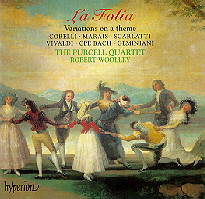 |
released February 1998
total duration 68'22"
A virtuoso performance of all Folias in a rather sober style unlike for instance the Vivaldi-performance of Il Giardino Armonico or the C.P.E. Bach-interpretation of Rafael Puyana. A nice opportunity to focus entirely on the comparison of the compositions, not distracted by different musicians, instruments or musical interpretations. When you are interested in all the introducing Baroque highlights of the 'later' Folia, this recording is highly recommended.
- Bach, Carl
Philipp Emanuel (1714-1788)
Robert Woolley plays all variations by C.P.E. Bach
Duration: 7'56" direct link to YouTube
© 1986 by Robert Woolley- Title: Variationen über die Folie d'Espagne, Wq118/9/H263 (1778)
- Performer: Robert Woolley (harpsichord solo)
- Duration: 7'56"
- Recording date: October 29/30, 1986
- Corelli,
Arcangelo (1653-1713)
The Purcell Quartet plays all variations by Arcangelo Corelli
Duration: 9'56" direct link to YouTube
© 1986 by The Purcell Quartet- Title: Sonata in D minor, Op. 5 No 12 (1700)
- Performers: Elizabeth Wallfisch (violin), Richard Boothby (cello), Robert Woolley (harpsichord)
- Duration: 9'56"
- Recording date: May 22-23, 1986 in St. Barnabas's Church, London
- Geminiani,
Francesco (1687-1762)
The Purcell Quartet plays all variations by Francesco Geminiani
Duration: 10'52" direct link to YouTube
© 1987 by The Purcell Quartet- Title: Concerto Grosso 'La Folia' (after Corelli) (1726)
- Performers: The Purcell Quartet: Catherine Mackintosh (violin), Elizabeth Wallfisch (violin), Richard Boothby (cello), Robert Woolley (harpsichord) and the Purcell Band: Pavlo Beznosiuk (violin I), Catherine Weiss (violin I), Henrietta Wayne (violin II), Francis Turner (violin II), Alan George (viola), Barry Guy (violone), Lucy Carolan (organ).
- Duration: 10'52"
- Recording date: June 4/5 and/or 12, 1987
- Marais, Marin
(1656-1728)
The Purcell Quartet plays all variations by Marin Marais
Duration: 16'22" direct link to YouTube
© 1988 by The Purcell Quartet- Title: Les Folies d'Espagne (1701)
- Performers: The Purcell Quartet: Catherine Mackintosh (violin), Elizabeth Wallfisch (violin), Richard Boothby (cello), Robert Woolley (harpsichord) with William Hunt (viola da gamba)
- Duration: 16'22"
- Recording date: May 1988 in the Church of St. Peter and All Saints, Petersham
- Scarlatti,
Alessandro (1660-1725)
Robert Woolley plays A. Scarlatti 's Folia as part of the Ottava stesa
Duration: 13'12" direct link to YouTube
© 1987 by The Purcell Quartet- Title: Folia from Toccata No 7 (Primo tono) from the Primo e Secondo Libro di Toccate (1715)
- Performer: Robert Woolley (harpsichord solo)
- Duration: 13'04"
- Recording date: April 1987
- Vivaldi,
Antonio (1678-1741)
The Purcell Quartet plays all variations by Antonio Vivaldi
Duration: 9'28" direct link to YouTube
© 1985 by The Purcell Quartet- Title: Trio Sonata in D minor (Variations on 'La Folia') RV63 (Op I No 12) (1705)
- Performers: The Purcell Quartet: Catherine Mackintosh (violin), Elizabeth Wallfisch (violin), Richard Boothby (cello), Robert Woolley (harpsichord) with William Hunt (viola da gamba)
- Duration: 9'28"
- Recording date: September 1985
Ruggero Laganà
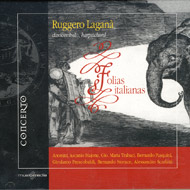 |
released August 2010
total duration 79'26"
If you are fond of the harpsichord as an instrument and of Folïas this disc is a must have! The only thing lacking is good references of the sources but there are absolutely no weaknesses on this fabulous disc to be found. If you think that so many folías will be monotomous and boring,which might be hard to avoid, I can assure you that Laganá is no metronomic automat but he has all the skills and knowledge about the pieces to paint a full indepth landscape.
This is not the first Folía-encounter for Ruggero who has corporated with the Amadeus-project and recorded previously the Alessandro Scarlatti's Folías variations, he also played at live recitals. For this disc he recorded the full Ottava Stesa including the wonderful parts which preceed the Folía-piece. Other compositions he previously recorded are the manuscript published by Martín Y Coll and the Pasquini Folías. So Laganà is in familiar territorium.
With the Follia di Spagna by Johann Baptist Cramer he had a première on the Amadeus disc, and there is another Folía premiere on this disc with "The Spanish Follye" I only heard once played on the organ by the late Ewald Kooyman although the piece is rather prominent mentioned in the study by Richard Hudson.
Not all pieces on this recording represents Folías. The central theme of the recording is Folías and the similar music from the region of Naples and Rome. Frescobaldi, Majone and Trabaci are represented with closely related Fidele as an arch type of music.
More about the disc at Concertoclassics http://www.concertoclassics.it/catalogo_dettagli.php?codice=31&pagina=2&dove=catalogo.php
.In music, the form foolia refers to a melodic pattern derived from a very old Carnevale dance - one of those restless, frenetic, impetuous dances in which everyone loses his head and every body loses its composure. Perhaps as Francisco de Salinas, the magister of the the University of Salamanca said in the 16th century, it originated in Portugal and, spreading quickly throughout the Iberian Peninsula, it immediateley became established in Europe. It appeared in the court music of the great 16th century virtuosos - as solo dances or in pairs.
Take for example the fascinating variations elaborated by Marin Marais for the viola da gamba. Later in the 17th century, it surfaced among the Arcadians, contributing to the definition of Arcangelo Corelli's violin style. It continued spreading throughout Germany among the pianists of the 18th century ... and we could carry on right up until today.
Leaving its Lusitanian origins, the so called Follia di Spagna became particulary successful thanks to its melody and the native simplicity of its harmony, as can be clearly heard in the many anonymous folía taken from collections dating to the early 1700's by the Biblioteca Nacional in Madrid. Organists and harpsichordists of various nationalities have been inspired by the Folia, but this CD focuses on its use in Italian music, in particular, from the Rome and Naples.
- Anonymous (c.1685 )
- Title: The Spanish Follye (1685)
- Duration: 2'06"
- Recording date: October 2009 Bartok Studio, Bernareggio (Mi), Italy
- Anonymous (1721)
- Title: Folias graves (1721)
- Duration: 2'09"
- Recording date: October 2009 Bartok Studio, Bernareggio (Mi), Italy
- .. (1956- )
- Title: Folia Folle (2008)
- Duration: 9'29"
- Recording date: October 2009 Bartok Studio, Bernareggio (Mi), Italy
- .. (1964- )
- Title: A Devil Behind the Mask (2008)
- Duration: 8'56"
- Recording date: October 2009 Bartok Studio, Bernareggio (Mi), Italy
- Martín y Coll, Antonio
(1709)
- Title: Las Folías
- Duration: 3'47"
- Recording date: October 2009 Bartok Studio, Bernareggio (Mi), Italy
- Pasquini, Bernardo (1637-1710)
- Title: Partite diversi di Follia
- Duration: 6'39"
- Recording date: October 2009 Bartok Studio, Bernareggio (Mi), Italy
- Pasquini, Bernardo (1637-1710)
- Title: Partite sopra la Aria della Folia de Espagna
- Duration: 1'35"
- Recording date: October 2009 Bartok Studio, Bernareggio (Mi), Italy
- Scarlatti, Alessandro (1660-1725)
- Title: Toccata per cembalo d'Ottava stesa (1723) (with), Variazioni sulla Follia di Spagna
- Duration: 18'52"
- Recording date: October 2009 Bartok Studio, Bernareggio (Mi), Italy
Anders Borbye
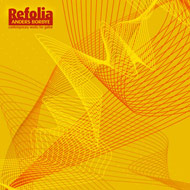 |
released October 2008
total duration 65'11"
Modern guitar music has the academical imago that it is artificial and therefore hardly accessible for ordinary listeners interested in serious tonal music. I guess that Anders Borbye had this prejudice in mind when he started this project to give it a fresh yet modern approach. Fascinated by the Folia theme he tried to extend the oeuvre into the 21st century by highlighting accessible yet startling modern guitar-Folias. Best of all he persuaded three Danish composers to write new Folia-compositions for his project which resulted in a well varied compact disc entirely devoted to the Folia-theme as a starting point. The demanding journey not only demonstrates a wide variety of guitar techniques ranging from tapping on the body of the guitar to bottleneck technique and an electric performance with flanger but also it shows the inventiveness of composers and the performer to handle such a small theme as the Folia because the theme is actually never far away.
Although the Folia-theme itself is exposed several times (for instance in the ending of Izarra's en Gunge's compositions) perhaps it would have been appropriate to play the bare theme as opening track just once as a statement for people not familiar with the theme.
Personally I consider the performance of Izarra's 'Lenta' (5'08") as the absolute highlight of the cd. Not only because it is played with flair very 'slowly' and vulnerable as an open nerve but probably these moments of reflections are even emphasized by the squeezed up-tempo pieces of the suite.
Although the pieces are all demanding the sound of all tracks is clear and there is never a moment where muffling of strings is to be heard in any way. The documentation of the disc is excellent. A project that gives new and fresh impulses to a very old idea.
More about Anders Borbye at http://www.andersborbye.dk
The idea with this CD is to present a programme of new music, which is uncomplicated and rewarding to listen to, even for people not familiar with such music. This is achieved by basing the music on a well known and quite simple melody, namely the Folia theme.
This theme has gone with me ever since the music school. It has in its basic form an inner cohesion which strongly appeals to my need for logic, purity and stringency. The guitar literture has some great works based on the folias, Sor, Giuliani and in the 20th century Ponce and Ohana. So I decided that the pieces on the CD should not be older than 30 years, which is just true with Malipiero. I wanted to have one world premier on the CD, but to my surprise 3 out of 4 composers I asked immediately said yes, and there I was with 3 world premiers!
Given the simplicity of the theme I am genuinely impressed with the creativity and fantasy shown by the composers, when theywork within this strict frame!
Judging from the history of music I am not the only one who has been fascinated by la Folia. There are hundreds of compositions based on the Folia theme, a lot of them for the guitar.
Three well known Danish composers, John Frandsen, Peter Bruun and Bo Gunge have written especially for this project. The other works on this CD were selected from a large number collected from all over the world. All composers involved have been very obliging, and have kindly contributed the notes for their works
- Bruun, Peter (1968- )

Duration: 1'00", 941 kB. (128kB/s, 44100Hz)
Fragment of Refolia, performance by Anders Borbye
© 2008 Anders Borbye, used with permission- Title: Refolia (2008)
- Duration: 6'15"
- Recording date: August-September 2008 in the Frederikskirken, Aarhus, Denmark
- World première
- Campo, Regis (1968- )
- Title: Sonate la Follia (1998)
- Duration: 3'28"
- Recording date: August-September 2008 in the Frederikskirken, Aarhus, Denmark
- Frandsen, John (1956- )

Duration: 0'43",651 kB. (128kB/s, 44100Hz)
Fragment of Folia Folle, performance by Anders Borbye
© 2008 Anders Borbye, used with permission- Title: Folia Folle (2008)
- Duration: 9'29"
- Recording date: August-September 2008 in the Frederikskirken, Aarhus, Denmark
- World première
- Gunge, Bo (1964- )

Duration: 1'01", 951 kB. (128kB/s, 44100Hz)
Fragment of A devil behind the mask,
performance by Anders Borbye
© 2008 Anders Borbye, used with permission- Title: A Devil Behind the Mask (2008)
- Duration: 8'56"
- Recording date: August-September 2008 in the Frederikskirken, Aarhus, Denmark
- World première
- Izarra, Adina (1959- )
- Title: Folías de España, sobre las Folías de Marina Marais de 1701 (1995)
- Duration: Introducción 0'38" Rápido 1'10" Muy rápido 1'25" Rápido, misterioso 2'19" Veloz 2'08" Lenta 5'08" Ansiosa, muy rápida 2'06" Final 2'02"
- Recording date: August-September 2008 in the Frederikskirken, Aarhus, Denmark
- Johanson, Bryan (1951- )
- Title: La Folia Folio (1995)
- Duration: 10'44"
- Recording date: August-September 2008 in the Frederikskirken, Aarhus, Denmark
- Malipiero, Riccardo (1914-2003)
- Title: Aria Variata, su la Follia (1979)
- Duration: 9'16"
- Recording date: August-September 2008 in the Frederikskirken, Aarhus, Denmark
'Espana en la Musica Europea de los Siglos XV al XVIII'
Genoveva Galvez
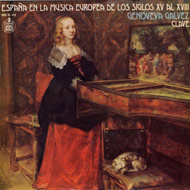 |
released 1977
total duration 42'45"
A recording centered aropund the theme of Spain in the title. No coincidence that three Folias were included.
Genoveva Galvez wrote about the Folia-theme in general::
La «Folía» es una danza portuguesa, cuyo origen
se remonta a tiempos muy antiguos. Ya Pedro 1,
al Justiciero, de Castilla, en el 1350, gustaba de
bailarla, A partir de 1500 se leen alusiones frecuentes
a esta danza en tratadistas de música
como Salinas, en literatos (Gil Vicente, Cervantes
.. . ), encontrándose, por otro lado, gra'n cantidad
de ejemplós musicales de ella en vihuelistas
y cancioneros. A principios del siglo XVII,
se pone de moda en toda Europa, con el nombre
de «Folía de España» ; casi todos los compositores
escribieron sobre este tema, baste decir
que, en tiempos más modernos, hasta Liszt y
Rachmaninoff han utilizado el tema de la «Folía»
en sus composiciones.
Alessandro Scarlatti (1660-1725), padre de Domenico,
el autor de tantas bellas sonatas para
e,1 clave, había trabajado con el gran Girolamo
Frescobaldi en Roma; de él aprendería la técnica
de la Variación, o «Partite», en la acepción italiana
más antigua de esta palabra. Existe, según
Willy Apel, un vínculo de unión entre Cabezón
y Frescobaldi a través de la escuela de tecla de
Nápoles, y de la que son exponentes magníficos
un Antonio Valente y otros compositores. La
«Folía», primitivamente danza, se , convierte en
tema básico de composición, y se presenta como
complejo armónico-melódico en el que están implicadas
las cuatro voces polifónicas (según el
mUSicólogo Miguel Quero!), pero cuya parte más
característica se sitúa en el bajo. Este bajo de
«Folía», se repite invariablemente a lo largo de
la obra como un bajo «ostinato». La «Folía» de
A. Scarlatti, de gran empeño virtuosístico, forma
parte integrante de una de sus «Toccatas».
Bernardo Pasquini (1637-1710) figura entre los
más insignes compositores italianos de tecla del
siglo XVII. En sus «Sonate per Gravicembalo»,
que incluyen toda clase de obras, desde «Toccatas
» o «Tastatas» a «Ricercares» y Variaciones,
muestra su fácil invención melódica, así como
una escritura a menudo influenciada por la música
violinística de la época. Su amor a la melodía,
a la suave cantabilidad italiana, influirá en
Handel, que trabajÓ con él en Italia.
Las «Folías de España», de C. Ph. E. Bach (1714-
1788) es una de las más cumpliélas obras escritas
con este tema. Sus diferentes variaciones
presentan fuertes contrastes. En 1759, C. Ph. E.
escribió en su «Vers"llch» o «Tratado sobre el verdadero
modo de tañer el clave» : ... - La música
ya no busca solo un placer de los oídos, 'sino
un desahogo de los más diversos sentimientos
del corazón». Dentro de esta nueva corriente estética,
de carácter subjetivo y personalista (que
en literatura recibe el nombre de «Sturm und
Drang») se sitúa su música para tecla; es, por
así decir, un anticipo del Romanticismo.
- Bach, Carl
Philippe Emanuel (1714-1788)
Folie d'Espagne performed Genoveva Galvez
Duration: 8'48" direct link to YouTube
© 1977 by Genoveva Galvez- Title: 12 Variations auf die Folie d'Espagne (1778)
- Performer: James Bonn (Dulcken fortepiano)
- Duration: 8'48"
- Recording date: not mentioned in the documention
- Pasquini, Bernardo (1637-1710)
Partite di Follia by Genoveva Galvez
Duration: 5'00" direct link to YouTube
© 1977 by Genoveva Galvez- Title: Partite di Follia (c.1697)
- Performer: James Bonn (Flemish harpsichord)
- Duration: 5'00"
- Recording date: not mentioned in the documention
- Scarlatti,
Alessandro (1660-1725)
Partite sull'Aria della Follia by JGenoveva Galvez
Duration: 19'05" direct link to YouTube
© Genoveva Galvez- Title: Partite sull'Aria della Follia
- Performer: Genoveva Galvez
- Duration: 7'05"
- Recording date: not mentioned in the documentation
Luigi Attademo
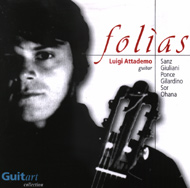 |
released 2001
total duration 59'35"
This compact disc was released by the Italian guitar magazine Guitart as the attachment of their quarterly issue. Unfortunately it is not yet distributed in the music shops outside Italy but only available through the magazine (guitart@guitart.it). However it is a great disc and worth attendance. First of all there are not that many recordings exclusively devoted to the Folia-theme and related music. The choice of repertoire is even more interesting because the Folia-variations of Angelo Gilardino, which are rather famous but hardly recorded because the high demands it requires of the guitar player, are the gravity center of this release. And it may be said, that piece is superbly played with flair and smootly, as expected by this gifted guitar player who attended seminars and masterclasses with Angelo Gilardino, so i guess the composer will be pleased with this performance.
Very helpful is the fact that all variations of the disc are indexed (47 tracks in total) so it is easy to skip to a particular variation or to make an analyse of pieces more easy. Even the Tiento by Maurice Ohana, which i personally consider as a non-folia (despite references in literature) because of its very remote association, sounds as a natural folia-conclusion in this context.
Although i am no connoisseur of guitar music, i like the natural tempi of the music. Lots of guitar players can't stand the temptation to play pieces as fast as possible which makes it a tour-de-force almost like a circus-act, but fortunately here the folias all sound in their right pace, at least the way i feel it. Further on the low basses sound cristal clear without overriding the treble-notes. But better judge for yourself because Luigi Attademo has put some samples in mp3-format (160 kbs) at his website http://www.luigiattademo.it/.
Luigi Attademo wrote for the slipcase (translation by Maya Bodo):
Nowadays the word insanity brings with it a meaning
which doesn’t leave any room to doubt, even though there may be several
meanings concealed in it. Between the two opposite poles of insanity
conceived as a disease, and insanity conceived as enthusiasm, each
artist is constantly looking for their particular characteristic, and
secret hiding places. The Iberian theme -the Folias - (a fast moving
dance) doesn’t have much to do with all this.
Such a path has its origin in Sanz, and ends up with the enigmatic
Ohana, touching pieces which are divided by different styles and
poetics, and it finally finds its center in Angelo Gilardino’s
Variazioni sulla Follia. It is not only by chance that they have been
conceived by their author as studies of Francisco Goya. Every time a
guitarist is looking into the guitar sound to be able to find the
meaning of human perceptions, and a way to give them back to their
audience, there is a reference to that particular poetic path.
Angelo Gilardino’s work rides Follía through hallucination. It
is only through hallucination that the world can be revealed in its
true sense. Without giving up the traditional way of composing with its
counterpoint, its interrupted and repeated themes, and its opposite
dynamics, Gilardino works out Follía again, and dives into it,
as an ancient alchemist, to develop diverse and unknown sounds. This
process transforms Follía into something that does not belong to
the author, into something that can be, at the same time, both
alienated and alienator. It is impossible to accomplish completely such
a kind of alchemistic process, and this is the reason why it ends up
with the quotation of Sor, another great guitarist who has chosen to
render and preserve the deepness and the torture of his thoughts by
means of a specific sound.
As far as this direction is concerned, Giuliani and Sor might seem
completely alien, yet their solidity is tinged with sadness which
marches side by side, for instance, with the fandango lively and
rhythmic reminiscence, which underlines the Iberian origin of the main
theme.
Gaspar Sanz compositions sound distant and almost impossible to listen
to, to our twentieth century ears. On the other side, the Tiento of
Maurice Ohana breaks through the Follía theme, and completely
tears it apart, enriching it with the mutation of a non-guitarist
composer.
Ponce is another non-guitarist composer connected to Andrés
Segovia’s figure, whose compositions are of great relevance. He is
surrounded by a traditional musical language, and this makes harmony
the real core of his expression. He makes the effort to compose a
monumental work, that is inspired by piano compositions, and that ends
- not by chance - with a fugue. He re-composes the theme again and
again in several different ways, broadening its shape. The result of
this process is a synthesis of his musical know how melded with some
kind of poetry of Segovian origin, which can be considered a milestone
in the way guitar sound has been conceived.
Preparing a collection containing these cycles of change can carry two
main purposes: walking through guitar history in a
linear way, showing at the same time that the artistic expression we
are looking for can appear in different ways, each one of them under
constant mutation, and both true and false at the same time. This can
appear alien to our perception, nevertheless it is part of that divine
madness which is the only component that can make the modern bard
strong enough to bear the impact with lack of meaning, which can be
considered the cause and the consequence of our insanity.
- Gilardino,
Angelo (1941- )
- Title: Variazioni sulla Follía (Studi da F. Goya) (1989)
- Duration: 1 Lento e pensoso 1'13", 2 Risoluto, ma non troppo mosso 0'59", 3 Andantino scorrevole e sommesso 0'59", 4 Allegro non troppo, ma assai energico 0'53", 5 Andantino appena mosso 1'56", 6 Allegretto 0'51", 7 Andante piuttosto lento 1'22", 8 Agitato 1'00" 9 Non troppo lento, con forte scansione 2'25", 10 Rapido e lieve 1'15", 11 Mosso, legato 1'22" 12 Liberamente, come preludiando F. Sor: Les Folies d'Espagne: Thème 1'21"
- Recording date: March 25 and 29 2001 at Quality Audio, Vercelli, Italy
- Guitar by Carlo Raspagni, 1996
- Giuliani,
Mauro (1781-1829)
- Title: Variazioni sul tema della Follia di Spagna op.45 (1814)
- Duration: 1 Tema: Andantino 0'45", 2 Variazione I 0'29", 3 Variazione II 0'22" 4 Variazione III 0'57", 5 Variazione IV 0'23", 6 Variazione V: un poco più adagio, Variazione VI 2'50"
- Recording date: March 25 and 29 2001 at Quality Audio, Vercelli, Italy
- Guitar by Carlo Raspagni, 1996
- Ohana, Maurice
(1914-1995)
- Title: Tiento (year of publication unknown)
- Duration: 4'54"
- Recording date: March 25 and 29 2001 at Quality Audio, Vercelli, Italy
- Guitar by Carlo Raspagni, 1996
- Ponce,
Manuel M. (1882-1948)
- Title: Variations sur 'Folia de España' et Fugue (1930)
- Duration: 25'35" All variations indexed
- You can listen to a fragment (opening) of the concluding fuga in MP3 (160 kb/s) at the website of Luigi Attademo http://www.luigiattademo.it/
- Recording date: March 25 and 29 2001 at Quality Audio, Vercelli, Italy
- Guitar by Carlo Raspagni, 1996
- Sanz, Caspar
(c.1640-c.1710)
- Title: Folías; (1674)
- Duration: 2'15"
- You can listen to the complete composition in MP3 (2,58 Mb) at the website of Luigi Attademo http://www.luigiattademo.it/
- Recording date: March 25 and 29 2001 at Quality Audio, Vercelli, Italy
- Guitar by Carlo Raspagni, 1996
- Sor, Fernando
(1778-1839)
- Title: Les Folies d'Espagne Variées e un Minuet op. 15a (c.1815)
- Duration: 1.re Variation 0'27", 2.me Variation 1'00", 3.me Variation 0'29", 4.me Variation 0'45", Menuet: Andante 2'00"
- Recording date: March 25 and 29 2001 at Quality Audio, Vercelli, Italy
- You can listen to the first variation in MP3 (542 kb) at the website of Luigi Attademo http://www.luigiattademo.it/
- Guitar by Carlo Raspagni, 1996
Hespèrion XXI conducted by Jordi Savall and other musicians
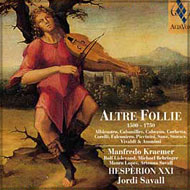 |
released September 2005
total duration 77'22"
Hesperion XXI plays Altre Follie (complete)
|
Chronologically, the timeline is respected much more with 'Altre Follie' to show the development of the Folia-styles as well as the diversity of instruments.
Once more there is no distinction made between the so called early or later Folias. There are some nice early Folias included like the ones by Cabanilles (hardly recorded), Cabezón, Corbetta, Piccinini and Storace.
The traditional instrumentation for the pieces is sometimes avoided and so some arrangements are surprizingly refreshing while others murder the soul of complete compositions. An example of the first category is the use of the 'arpa triple' as part of the b.c. in Faronell's Division which gives a charming and sparkling sound to the piece.
However I fail to see the purpose the way the Falconiero (Falconieri) is treated. Such a beautiful piece with three clear different voices tumbling over each other until they meet in unison at the very end (Falconieri gave the title the addition 'a 3' with good reason). Hespèrion XXI brings in 6 instruments and with 2 voices played by the same instruments (violin) and a b.c. without any unity (sometimes the theorbo disappears and in the opposite channel the harpsichord takes over). The result is a symphonic receptacle without any notion for the three interacting voices.
Peculiar is the way the harpsichord is recorded. Are the microphones deliberately positioned at a distance? The effect is that it seems that the harpsichord is not one of the pillars in the music. Especially when the instrument is put only in the right channel of the panorama (Falconiero) instead of a basso continuo that should be in the middle of the spectrum with the firm sound close at hand.
Let's not overestimate these minor irritations because most things are a treat. Extremely nice is the way Lislevand has engineered 'his' Folias taking different lines from the compositions of Corbetta and Sanz, to assemble the material into a 'new' piece with a familiar sound. Highlight of the disc I consider the composition by Albicastro. The only recorded version I know is of a magical spell recorded by Ensemble 415 and this version shows the same beauty and melancholy and as a bonus added a cheerful variation halfway the piece (written in the original score?) without breaking the magic reflection of the soul of the music.
The documentation of the disc is as always extremely nice with good texts in six languages and lots of photos.
In 2005 Rui Vieira Nery (University of Évora, Portugal) wrote for the slipcase (just quoting the text in regard to the later Folia):
In the seventeenth century several influential Italian composers
left us sets of Folia variations: the lutenist Alessandro Piccinini (1566-1638)
in his Intavolatura di Liuto (Bologna, 1623), for chitarrone; yet another lutenist,
Andrea Falconieri (1585/6-1656), in his Il Primo Libro di Canzone (Naples, 1650)
for two violins and continuo; the organist Bernardo Storace in his Selva di
Varie compositioni (Venice., 1664), for keyboard; the guitarist Francesco Corbetta
(d.1681), in his La Guitarre Royale (Paris, 1671), for his own instrument.
Corbetta seems to be one of the first authors to superimpose to the traditional
bass of the Folia the characteristic treble melody in triple meter, with a dotted
second beat in each measure, that was to become associated with the genre from
the late seventeenth century on. In fact, Gaspar Sanz' 1674 version was basically
an adaptation of Corbetta's setting., which the Spanish master must have acquired
shortly after its publication in Paris. This same combination of upper melody
and harmonic bass circulated widely all over Europe and became a favourite object
for variations, first in France itself, where it was employed by Lully and Marais,
then in Germany, the Netherlands and England, where the publisher John Playford
(16231687/88) included a set of Folia variations for the violin in his instrumental
collection The Division Viol (London, 1685), under the title "Faronell's
Division", which seems to have been traditionally associated with the Folia
in that country. At the same time, the most commercially successful French and
Italian dance treatises of the period, such as those by Feuillet (1700) and
by Lambranzi (1716), spread the tune and the basic steps of this "Folie
d'Espagne" through all the European market.
With the development of the virtuosic repertoire for the violin at the turn
of the century it was only natural that the Folia should be included in it.
In 1700 the great Arcangelo Corelli (1653-1713) used it as the basis for a series of exceedingly virtuosic variations with which
he concluded his most influential collection of solo sonatas for violin and continuo, the famous Op. 5, the contents
of which are known to have circulated in manuscript for more than a decade prior to this
printing. In 1704 one of the most representative composers of violin music of the German and Dutch
school, Henricus Albicastro, an artistic pseudonym of Johann Heinrich von Weissenburg
(ca. 1660 -ca. 1730), published a sonata "La Follia", which displays a clear Corellian influence
in its virtuosic writing. And it was not by accident that a year later, in 1705, the young Antonio Vivaldi
(1678-1741) also chose to conclude a decisive publication in which he placed the highest hopes
for the future of his artistic career, his Op. 1 collection of trio-sonatas, with yet another magnificent
set of Folia variations.
The old Portuguese peasant dance had come a long way. To the very end of the
Baroque period it would remain one of the strongest unifying traits of European instrumental music,
a well-known basis upon which musicians from all nations could improvise together without
any barrier of language or of musical tradition, and a successful source of inspiration for any composer who wished
to impress the European music community at large with his skills. On the contrary, Classicism,
in its search for larger formal structures in music, was not so interested in ostinato basses,
but still the Folia was yet to be occasionally rediscovered by the Romantics, at the hands
of such masters as Liszt or Rachmaninov.
- Albicastro
(von Blankenburg or Weissenburg), Henrico (1661-unknown)
Hesperion XXI plays Albicastro
Duration: 11'41" direct link to YouTube
© 2005 by Alia Vox- Title: Sonata "La Follia"
- Performers: Kraemer, Manfredo (violin), Ruiz, Mercedes (violoncelle), Behringer, Michael (harpsichord)
- Duration: 11'41"
- Recording date: February 28-March 3 and June 6-9, 2005 in the Collégiale of the Château de Cardona, Catalogne
- Corelli,
Arcangelo (1653-1713)
- Title: Follia (1700)
- Performers: Manfredo Kraemer (violin), Balazs Mate (violoncello), Xavier Díaz-Latorre (guitar), Carlos García-Bernalt (harpsichord)
- Duration: 11'00"
- Recording date: February 28-March 3 and June 6-9, 2005 in the Collégiale of the Château de Cardona, Catalogne
- Falconiero (Falconieri), Andrea (c.1575-c.1661)
Hesperion XXI plays Falconieri
Duration: 4'29" direct link to YouTube
© 2005 by Alia Vox- Title: Folias (a 3) echa para mi Señora Doña Tarolilla de Carallenos
- Performers: Manfredo Kraemer (violin), Mauro Lopes (violin), Balazs Mate (violoncello), Xavier Puertas (violone), Xavier Díaz-Latorre (theorbo), Carlos García-Bernalt (harpsichord)
- Duration: 4'32"
- Recording date: February 28-March 3 and June 6-9, 2005 in the Collégiale of the Château de Cardona, Catalogne
- Farinel(li), Michel (c.1649-unknown)
- Title: John Playford: Faronell's Division (1684)
- Performers: Manfredo Kraemer (violin), Jordi Savall (basse de viole), Arianna Savall (arpa triple)
- Duration: 5'07"
- Recording date: February 28-March 3 and June 6-9, 2005 in the Collégiale of the Château de Cardona, Catalogne
- Sanz, Caspar (& Francesco Corbetta) (1640-1710)
- Title: Folias (1674)
- Performer: Rolf Lislevand (guitar)
- Duration: 3'14"
- Recording date: February 28-March 3 and June 6-9, 2005 in the Collégiale of the Château de Cardona, Catalogne
- Vivaldi, Antonio (1678-1741)
- Title: Sonata "La Follia" Op.1 n.12 RV63 (1705)
- Performers: Manfredo Kraemer (violin), Mauro Lopes (violin), Balazs Mate (violoncello), Xavier Puertas (violone), Xavier Díaz-Latorre (guitar), Carlos García-Bernalt (harpsichord)
- Duration: 9'44"
- Recording date: February 28-March 3 and June 6-9, 2005 in the Collégiale of the Château de Cardona, Catalogne
Ruggero Laganà joined by
M. Pennicchi (soprano), M. Lonardi (archlute & vihuela), P. Beschi (violoncello), F.C. Quatu (sopranistu), T. Bracci (bass)
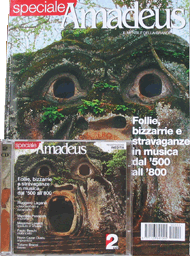 |
released April 2005
total duration 148'39"
This extraordinary double compact disc set was released by the Italian magazine Amadeus (15th year No. 2, April 2005) as the attachment of their issue which was completely devoted to the la Folia-theme in music edited by Pinuccia Carrer, professor of musical history at the conservatory of Milan.
The only disadvantage is that all documentation is in the Italian language, but sources are well documented and every detail both of the music as the magazine is taken care of with precision.
The discs contain lots of 'later' Folias, but also some early Folias, famous in literature but hardly recorded like the one written by Giovanni Stefani and the beautiful piece for vihuela by Diego Pisador. The best thing about the music, which is mainly for keyboard (harpsichord and fortepiano) is that almost every piece of music is indexed (visible in the display of the cd-player) and even the number of bars is indicated in the slipcase. This is an extra dimension which invites to examine the pieces even more closely.
Besides these Folias there is a selection of music included like the famous fandango by Antonio Soler, the Capriccio op. 34 no 1 by Muzio Clementi and the Fantasie in G min op. 77 by Beethoven which are out of the ordinary in their own field.
The only thing I cannot understand is why the Prelude and Sarabande (3rd Suite in d minor) of Jean-Henry d'Anglebert is included and his most famous Folies d'Espagne from the same bundle is left out of the selection. I guess it will be all explained in the detailed documentation, but unfortunately I cannot read any Italian and that is my only frustration of this fantastic release.
- Bach, Carl Philipp Emanuel
Maestro Laganà plays 12 Variations auf die Folie d'Espagne (Wotq 118/9 H. 263)
Duration: 8'04" direct link to YouTube
© 2005 by Ruggero Laganà- Title: 12 Variations auf die Folie d'Espagne (Wotq 118/9 H. 263)
- Duration: 8'04"
- Recording date: August 18-19 and November 15-19, 2004 in Chiesa di S. Maria Incoronata, Martinengo (Bg), Italy
- All variations nicely indexed
- Cramer, Johann Baptist
- Title: Follia di Spagna
- Duration: 3'53" (duration of Divertimento X: 18'49")
- Recording date: August 18-19 and November 15-19, 2004 in Chiesa di S. Maria Incoronata, Martinengo (Bg), Italy
- All variations nicely indexed
- Händel, Georg Friedrich
Maestro Laganà plays Sarabande by Händel
Duration: 4'43" direct link to YouTube
© 2005 by Ruggero Laganà- Title: Sarabanda e variazioni dalla Suite in re minore per clavicembalo
- Duration: 4'43"
- Recording date: August 18-19 and November 15-19, 2004 in Chiesa di S. Maria Incoronata, Martinengo (Bg), Italy
- All variations nicely indexed
- Martín Y Coll, Antonio
Theme and 3 variations.
Source: in Huerto ameno de varias flores de música recogidas de muchos organistas por Fray Antonio Martín 1708, Madrid, Bibliotheca Nacional, Ms 1359, pp 593-595.- Title: Folias (1708, tema di Follia di 7 battute ripetute e variate quattro volte, con diminuzioni)
- Duration: 1'42"
- Recording date: August 18-19 and November 15-19, 2004 in Chiesa di S. Maria Incoronata, Martinengo (Bg), Italy
- Martín Y Coll, Antonio
Theme and 8 variations
Source: in Huerto ameno de varias flores de música recogidas de muchos organistas por Fray Antonio Martín 1709, Madrid, Bibliotheca Nacional, Ms 1360, ff. 215v-217v- Title: Otras Folias per clavicembalo (1709)
- Duration: 2'17"
- Recording date: August 18-19 and November 15-19, 2004 in Chiesa di S. Maria Incoronata, Martinengo (Bg), Italy
- Three parts of variations nicely indexed
- Martín Y Coll, Antonio
Theme and 7 variations
Source: in Pensil deleitoso de suabes flores de música recognidas de varios organistas por F. Antonio Martín 1707, ff. 68r-69r.- Title: Tonos de Palacio - Folias (1707, Tema di Follia di 8 battute ripetute con otto variazioni)
- Duration: 2'22"
- Recording date: August 18-19 and November 15-19, 2004 in Chiesa di S. Maria Incoronata, Martinengo (Bg), Italy
- Pasquini, Bernardo
Source: Staatsbibliothek Berlin Preuäischer Kulturbesitz, Landsberg 215 - Parte IIIMaestro Laganà plays Partite diversi sopra Follia
Duration: 7'24" direct link to YouTube
© 2005 by Ruggero Laganà- Title: Partite diversi sopra Follia (ca. 1697)
- Duration: 7'24"
- Recording date: August 18-19 and November 15-19, 2004 in Chiesa di S. Maria Incoronata, Martinengo (Bg), Italy
- All variations nicely indexed
- Scarlatti, Alessandro
Source: GB-Lbl, una più tarda versione in US-NH, in Toccate per cemalo, a cura di J.S. Shedlock, London 1908- Title: Variazioni sopra la Follia di Spagna (1723)
- Duration: 8'24"
- Recording date: August 18-19 and November 15-19, 2004 in Chiesa di S. Maria Incoronata, Martinengo (Bg), Italy
- All variations nicely indexed
Ensemble Oni Wytars
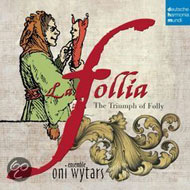 |
released 2013
total duration 61'51"
In 2011 it was exaclty 500 years ago that "In Praise of Folly" by Erasmus of Rotterdam was published. It was a moment of extra focus for the essay. Since Folly (literally meaning "madness") can be translated to Folia or Follia in Italian it can easily be associated with the famous archtype La Folia in music. The occasion for musicians to consider to do something with this achtype in music in connection to Erasmus.
Jordi Savall released in 2012 a pacxkage of 6 compact discs and more than 500 pages of text by Erasmus in several languages where the praise of Folly was the central theme. Most tracks however were recorded before and only one later original Folía was included by the harpist Andrew Lawrence King.
This disc by Ensemble Oni Wytars is considering the musical archtype La Folia far more interesting. Besides lots of early Folías like the well-known pieces by Ortiz, an arragement of Piccini for keyboard (originally chitarrone) and the hauting tune by Baldano (also recorded by La Cetra d'Orfeo), six later folías were included. The Falconieri is a rather standard version but the Folies d'Espagne by Chediville was not yet recorded as far as I know. The remaining folías are very original improvisations by masters on their instruments (Harrison and Pessi), a Scandinavian setting for an Italian Folia by Corelli (Ambrosini) and a full arragement for voices based upon Vivaldi's Follia (Sontata "La Follia"). The only disadvantage is that the documentation about the sources, although the texts are in three languagues, is rather poorly. They rather like to play the tunes than doing research and justify their choices. The folly for every librarian looking for the original manuscripts, so be it.
The Members of the Ensemble Oni Wytars are:
Belinda Sykes, voice Gabriella Aiello, voice Su Ehlers, voice Peter Rabanser voice, ceccola polifonica, baroque guitar lan Hariison, bagpipes, cornet, voice
Riccardo Delfino, hurdy-gurdy, harp, bagpipes, voice Jule Bauer, tenor nyckelharpa, voice Katharina Dustmann, percussion Carlo Rizzo, Tamburello, tambourin polytimbral Michael Posch, recorders Giovanna Pessi, harp Jane Achtmann, Viola da gamba, Michael Behringer, organ Marco Ambrosini, nyckelharpa, jew's harp and director
An impression of the recording session October 2011
|
Marco Ambrosini wrote for the slipcase (in a translation by Ian Harrison & Peter Rabanser):
500 years ago saw the publication of Erasmus of Rotterdam's famous book The Praise of Folly. In this essay Erasmus praised Folly in a humorous and virtuoso way, depicting her
as a benevolent goddess, who has inspired the human race since time immemorial, ever protecting
us from the bitter seriousness of life.
There is no musical genre that comes closer to this world view, and expresses it more
accurately, than the Follia, or Folia, a form of composition which has been a major factor of western music history from the 15th century to the present day. Hundreds of composers have
dared to approach - and relished - the Follia; there is hardly a famous musician who has not
put his or her signature to at least one such composition. It is a constant temptation, an
addiction; each new variation should - in the truest sense of the word - be crazier than the previous one. The list of Follia compositions, which extends from the Renaissance to contemporary
pop and rock music is indeed long and impressive.
These are many good reasons for the ensemble Oni Wytars to continue this unbroken tradition, to adorn it with new facets and sounds, to look at it afresh, and to present to modern audiences this constantly self-reinventing world of the Follia. An impressive selection of exotic and ancient instruments such as baroque hurdy-gurdy, nyckelharpa, chitarra, battente, doublé harp, polyphonic bagpipes, cornet, recorder, organ, viola da gamba and various types of percussions meet with rather unconventional vocals expressing sometimes grotesque and foolish texts from the Mediterranean Baroque. Follias by anonymous masters mingle with folk songs and then lose themselves in the well-known instrumental works by Vivaldi and Corelli; boundaries melt away until the composers just step aside and listen with a smile. The Follia emancipates itself from the shackles of written texts and the standard repertoire, it recreates itself and bursts, along with the song, into a real musical firework full of highly virtuoso improvisation, joy, imagination and of course ... Folly!
- Ambrozini, Marco (1964- )
- Title:Follia d'Arcangelo (2011)
- Duration: 0'37"
- Recording date: October 1-3, 2011 in Kurtheater, Bad Kissingen, Germany
- Chédéville, Nicolas (1705-1782)
- Title: Les Folies d'Espagne (c. 1750)
- Duration: 2'44"
- Recording date: October 1-3, 2011 in Kurtheater, Bad Kissingen, Germany
- Ensemble Oni Wytars
(Ensemble) based upon Vivaldi
- Title: Sonata "La Follia" (2011)
- Duration: 10'01"
- Recording date: October 1-3, 2011 in Kurtheater, Bad Kissingen, Germany
- Falconieri, Andrea
(1585-1656)
- Title: Follia (1650)
- Duration: 2'08"
- Recording date: October 1-3, 2011 in Kurtheater, Bad
- Harrison, Ian
(? - )
- Title: Folia Gaitata (2011)
- Duration: 2'08"
- Recording date: October 1-3, 2011 in Kurtheater, Bad Kissingen, Germany
- Pessi, Giovanna (?- )
- Title: Follia dell'Arpa (2011)
- Duration: 1'20"
- Recording date: October 1-3, 2011 in Kurtheater, Bad Kissingen, Germany
Yves Storms
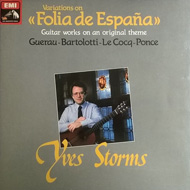 |
released 1983
total duration 45'01"
In this recording are three massive sets of variations included on the 'later'folia-theme and one set of early Folias by Barttolotti.
Peter Pieters wrote for the inlay of this vinyl recording:
In Baroque times, no melody or chord
schema was more often used in
variations than the Folly from Spain.
Incontestably, Corelli's «La Folia» is the
most famous, but even ].S. Bach used the
theme' in his «Peasant Cantata».
Originally, the Folly was a wild dance, in which men in carnival costume often
~eached a state of hysterical trance. The Church did not approve and as a result
the Folly was gradually transformed into
the slow, solemn melody we know today
The Folly was extremely popular among baroque guitar players, to the
point that Robert de Visee - almost alone in not publishing one - felt it
necessary to write in his introduction:
«Neither will one find here the Spanish Folly. So many of these are now to be
heard, that I could only repeat the follie of others».
There is not the space here to list all the Follies written for the Baroque
Guitar, but the three collected on this record are among the most beautiful:
that of the Spaniard F. Gereau, the Brussels-born F. Le Cocq and the ltalian
A.M.B. whose works have been neglect to this day.
In later times as well, guitar players have shown their partiality for the Spanish Folly and the two greatest guitar composers of the 19th Century, Fernando Sor and M. Giuliani, wrote variations on
these themes. In our own times the Mexican Manuel Ponce, who wrote principally for the guitar,
also composed some Follies; indeed, his most important work comprises no less than 20 variations
followed by a majestic fugue.
- Bartolotti,
Angelo Michele ( (c. 1615-after 1650)
- Follias (1640)
- Performers: Yves Storms
- Duration: 3'22"
- Recording date: not indicated in the slipcase
- Cocq, François le
(c.1685-1729)
- Title: Les Folies d'Espagne (1729)
- Performer: Yves Storms
- Duration: 7'30"
- Recording date: not indicated in the slipcase
- Guereau, Francisco (1649 – 1717/1722)
- Title: Doze diferenncias de folias from Poema Harmonico (1694)
- Performers: Yves Storms
- Duration: 4'20"
- Recording date: not indicated in the slipcase
- Ponce, Manuel
(1882-1948)
- Title: Variations sur la Folia D'España (1930)
- Performers: Yves Storms
- Duration: 29'23"
- Recording date: not indicated in the slipcase
Various artists
 |
released 1995
total duration 63'54"
This compact disc released by the Institut für Didaktik populärer Musik in Oldershausen, Germany was primarily intended as a listening tool for students. Nowadays the institute bares the name of Lugert Verlag and for educational purposes the compact disc is available for 29 DM and shipments costs. For further information mail to leserservice@lugert-verlag.de or visit their website http://www.lugert-verlag.de
It must be a fine organisation to release such appealing educational material. All the tracks are examples of different Folias and the choices are well made in a chronological order, not disturbed by the commercial interests of record-companies or artists. The slipcase is very informative and although no sources are mentioned the material is clearly based on several studies by Richard Hudson. It is a relief to find a confirmation of many statements about the Folia, so i guess we studied the same material.
Although Lully is mentioned in the slipcase as the composer to introduce the first 'later' Folia in an Air, unfortunately not a fragment of this music is included.
The disc starts with the only early Folia presented here, the Recercada Ottava sobre La Folia by Daniel Ortiz in a performance of Hesperion XX (Savall). The Farinel (Farinel's Ground), and Sanz (Folia) are abridged to half a minute, i guess to respect the copyrights by Trio Sonnerie and J.M. Moreno. The Marais contains half of all variations and is played in a modern 'romantic' version for violoncello and piano. Not my cup of tea when you are used to the dark tones of the viola da gamba and harpsichord.
So far the minor dissonants, the rest of the disc is a feast for the ears and imagination. To start with the Sarabande by Händel from the 11th keyboard suite in an arrangment for orchestra (similar to the film music Barry Lyndon). I still consider the Sarabande as a Foolia, a deviation from the standard Folia-theme and not a genuine Folia, but the Sarabande is widely known and accepted as 'The Folia by Händel'. Here it illustrates nicely the adaptation by Händel of the Folia-theme. He must have had this tune in mind when composing it. In the slipcase is nicely documented the chord progression of the piece and the difference with the Folia-theme. The final track is a treat. Not the expected Manuel Ponce, but a very modern and popular one. A Folia in disguise and the composer himself has not mentioned a single syllable about the Folia-theme ('all compositions by Vangelis' it is stated in the original slipcase of the film-music by Vangelis). I knew the tune for some years when some-one told me that this music was a Folia. When picking up the guitar I could play the theme instantly using the Folia chord progression in d minor. Emphasizing the first count in every bar instead of the traditional second one, is clouding one's mind, especially with that bolero-rhythm on the background. Vangelis could not lead the personel of the Institut in Oldershausen up the garden path so easily.
A fine effort to illustrate the impact of the theme, especially when you bare in mind that the year of release was 1995 and that is before the release of most other compact discs with the Folia as thematical subject (like the Hyperion and Savall).
Wulf Dieter Lugert wrote for the slipcase (used with permission and © Institut für Didaktik populärer Musik):
Der Name 'Folia' taucht schon um 1500 in der
portugiesische Dichtung und in Hofchroniken als Bezeichnung eines Tanz
auf. Einer Schilderung aus dem Jahr 1610 können wir entnehmen,
daß es sich um einen sehr lauten und lebhaften Tanz verkleideter
Tänzer gehandelt hat:
'Es handelt sich um einen gewissen portugiesischen, sehr lauten
Tanz, denn viele Figuren werden mit Trommeln und anderen Instrumenten
ausgeführt. Verkleidete Lassträger tragen auf ihren Schultern
junge Männer in Frauenkleidung, die mit erhobenen Armen
umherziehen, tanzen und Trommeln spielen, und der Krach ist derartig
laut und der Rhythmus so schnell, daß es scheint, als haben die
einer oder die anderen den Verstand verloren. Daher gaben sie dem Tanz
den Namen 'Folia', nach dem toskanischen Wort 'folle', das nichtig,
verrückt, sinnlos, den Verstand verloren haben, bedeutet'
Bereits 1553 schildert Diego Ortiz ein Satzmodell für die Folia:

Diese Harmonienfolge läßt sich an der Einspielung dieser
Folge durch die auf
alte Musik spezialisierte Gruppe 'Hesperion XX 91) verfolgen (g-Moll: D
/ D / g / F / B / F / g / D ://). Verwendet man hier statt D-Dur im
ersten Akkord (im Notenbild A-Dur) g-Moll (imNotenbild den in Klammern
gesetzten Akkord d-Moll), so ist das
bereits die Grundlage des späteren stereotyp verwendeten Schemas.
Das früheste Beispiel für das hier in Beispielen
zusammengestellte beliebte harmonische und melodische Modell der
späteren Folia (in Frankreich auch 'Folies d'Espagne' genannt) ist
1672 eine Air von Lully.
1674 wurde die Folia von G. Sanz (u.a. Kapellmeister am spanischen Hof)
in seiner Gitarren-Instruktion veröffentlicht (3).
1685 erschien in der Sammlung 'The division Violin' des Londoner
Musikverlegers John Playford (bekannt vor allem durch seine Sammlung
von Country-Dances, die von der Jugendmusikbewegung wieder entdeckt
wurden)
eine Melodie des franzosischen Komponisten John Farinel (getauft 1649,
Todesjahr unbekannt).
Diese sarabandenartige Melodie wurde in Engeland äußerst
populär und 'Farinels Ground' (2) genannt.
Michel Farinel war zeitweise Musikdirektor am Hof von Spanien, 1688
Violonist bei Ludwig dem XIV, in Versailles.
Auf dem Kontinent wurde diese, in der Folge mit der Folia verbundene
Melodie und Harmonienfolge vor allem
durch die Variationen für Klavier und Violine (op.5, Sonate 12)
von A. Corelli (1700) (4) und die Folia-Variationen für Klavier
und Viola da Gamba von Marin Marais (1701) (5) bekannt. Interessant ist
dabei daß durchweg die Tonart d-Moll verwendet wird. Bei der
vorliegenden Einspielung (4) werden die zur
Zeit Corellis üblichen improvisierten Verzierungstechniken
verwendet.
Gottlieb Taubert bezeichnete 1717 in seiner Tanzschule diese Melodie
als die 'berümteste aller Sarabandenmelodien' und gebrauchte sie
dementsprechend zur Übung der Sarabande. In der Lauten- und
Gitarrenliteratur des 17. Jahrhunderts finden sich zahllose weitere
Sarabanden mit dieser Harmonienfolge.
Auch G.F. Händels berümte Sarabande aus der Suite für
Cembalo in d-moll (6) ähnelt sehr stark dem Folia-Schema: d-Moll /
A-Dur / F-Dur / C-Dur / g-Moll / d-Moll / B-Dur / A-Dur //.
Welch große Popularität die 'Folie d'Espagne' hatte, zeigt
sich auch daran, daß viele Komponisten
bis ins 20. Jh. hinein sich mit ihr beschäftigten.
Hier sollen nur die bekanntesten Beispiele aufgelistet werden:
- 1722 verwendet J.S. Bach in einer Arie der 'Bauern-Kantate' (7) das
Folia-Thema
- 1728 wird das Folia-thema in der 'Beggars Opera' verwendet
- 1863 komponiert Liszt die 'Rhapsodie Espagnole' über dieses
Schema (8)
- 1932 'Variationen über ein Thema von Corelli' von Rachmaninov (9)
- 1994 wird die Filmmusik 'Conquest Of Paradise (10) von Vangelis, die
im 1. Teil die Folia-Harmonik verwendet, ein Nr.1-Hit in Deutschland
Otto Gombosi geht übrigens in seinem 'Folia'-Beitrag in der 'Musik
in Geschichte und Gegenwart' soweit, die Folia mit dem Blues und
Boogie-Woogie zu vergleichen.
Unterrichtsmaterialien zur Folia finden sich in der 'Zeitschrift
für die Praxis des Musikunterrichts', Heft 42 und 43.
- Farinel,
Michel (1649-unknown)
- Title: Farinels Ground (1685)
- Performers: Trio Sonnerie
- Duration: 0'37"
- Recording date: not indicated in the slipcase
- Sanz, Caspar
(1640-1710)
- Title: Folia (1674)
- Performer: J.M. Moreno
- Duration: 0'22"
- Recording date: not indicated in the slipcase
- Corelli,
Arcangelo (1653-1713)
- Title: Follia, Sonate Nr. 12 für Violine und Cembalo (1700)
- Performers: Trio Sonnerie
- Duration: 11'09"
- Recording date: not indicated in the slipcase
- Marais, Marin
(1656-1728)
- Title: La Folia (1701)
- Performers: A. Gastinel (violoncello) and S. Bossard (piano)
- Duration: 8'45"
- Recording date: not indicated in the slipcase
- Händel,
George Frideric (1685-1759)
- Title: Sarabande aus der Suite für Cembalo d-Moll (1727)
- Performers: English Chamber Orchestra conducted by Leppard
- Duration: 2'59"
- Recording date: not indicated in the slipcase
- Bach, Johann
Sebastian (1685-1750)
- Title: Folia aus der Bauernkantate (1742)
- Performers: Chamber Orchestra Budapest
- Duration: 1'25"
- Recording date: not indicated in the slipcase
- Liszt, Franz
(1811-1886)
- Title: Rhapsodie espagnole (1867)
- Performer: Bernd Glemser
- Duration: 12'40"
- Recording date: not indicated in the slipcase
- Rachmaninov,
Sergei (1873-1943)
- Title: Variationen für Klavier über ein Thema von Corelli (1932)
- Performer: Idil Biret
- Duration: 19'15"
- Recording date: not indicated in the slipcase
- Papathanassiou
(Vangelis) (1943- )
- Title: Conquest of Paradise (1992)
- Performers: Vangelis and others
- Duration: 4'51"
- Recording date: not indicated in the slipcase
Jordi Savall
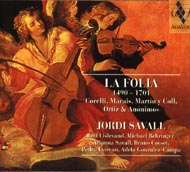 |
released November 1998
total duration 54'25"
Hesperion XXI plays La Folia (complete)
|
In 1998 Rui Vieira Nery (Universidado Nova de Lisboa) wrote for the slipcase (just quoting the text in regard to the later Folia):
The Folia is one of the several dances and dance
songs of popular origin which developed in the Iberian Peninsula in
late Middle Ages and may have been used in their original context for
quite some time before they were later assimilated by the courtly
polyphonic repertoire, both vocal and instrumental, in the late 15th
and in the early 16th century.
By the last quarter of the 17th century, however, the Folia undergoes a
process of further standardisation, with the above-given version of the
bass line (quoted from above: usually in two segments, A-E-A-G-C-G-A-E
and A-E-G-C-G-A-E-A, or slightly altered versions thereof) becoming the
norm (each of the piches being assigned a measure-long durational
value, in triple meter), as well as with a standard discant tune
associated to the harmonic sequence thus obtained. All over Europe, and
throughout the 18th century, it now becomes one of the best loved
grounds for highly virtuosic
instrumental variations, at the hands of such important composers as
Corelli, Alessandro Scarlatti, Vivaldi and Buononcini, in Italy, Marais
and D'Anglebert
in France, or Johann Sebastian and Carl Philipp Emanuel Bach, in
Germany. Corelli's 'La Follia', included in his famous 1700 Op. 5
collection of solo Sonatas for violin and continuo, was especially
influential in shaping a wide gamut of variation patterns on this
theme, which were then widely imitated by countless minor composers.
Needless to say, even in its new standardized Baroque version, it
remains a staple of the Iberian 17th and 18th century instrumental
repertoire, a particularly
charming example being the setting in Antonio Martín y Coll's
manuscript
collection 'Flores de Música (ca. 1690), for instance. Cherubini
will later pay homage to its Portuguese origin by using it as the main
theme for the ouverture of his 1798 opera 'L'hôtellerie
portugaise', and even some of the Romantic piano virtuosos, as late as
1867 (Liszt, Rhapsodie espagnole)
and 1931 (Rachmaninov, Variations on a theme by Corelli), will use it
as a symbol of continuity with a grand tradition of almost three
centuries of brilliant variation writing for the keyboard.
- Corelli,
Arcangelo (1653-1713)
- Title: Follias, Op. 5 Roma (1700)
- Performers: Jordi Savall (viola da gamba [soprano]), Bruno Cocset (basse de violon), Michael Behringer (harpsichord)
- Duration: 11'08"
- Recording date: July 31 and/or August 1-2, 1998 in the Studio Fondation Tibor Varga, Sion (Switserland)
- Marais, Marin
(1656-1728)
- Title: Couplets de Folies, second book (1701)
- Performers: Jordi Savall (basse de viole with 7 strings), Rolf Lislevand (theorbe), Michael Behringer (harpsichord)
- Duration: 18'07"
- Recording date: September 21-22 in the Church of St. Hippolyte in Castres, France
- Martin y
Coll, Antonio (?-after 1734)
Jordi Savall and friends
Duration: 10'56" direct link to YouTube
© 1998 by Jordi Savall- Title: Diferencias sobre las Folias (c.1707)
- Performers: Jordi Savall (viola da gamba [basse]), Arianna Savall (harpe triple), Rolf Lislevand (guitar), Adela Gonzalez-Campa (castagnettes)
- Duration: 10'48"
- Recording date: July 31 and/or August 1-2, 1998 in the Studio Fondation Tibor Varga, Sion (Switserland)
Stephen Stubbs joined by
Milos Valent (violin, viola), Maxine Eilander (Spanish and Italian harps), Erin Headley (viola da gamba, lirone)
 |
released 2006
total duration 74'22"
Stephen Stubbs as lute and baroque guitar player is likely to be very familiar with the concept of the Folia as a member of several ensembles who recorded Folias in one way or the other. Already in 1989 he recorded with the ensemble 'Circa 1500' a two-line piece by Machado where a 'later' Folia improvisation was added to give the piece some body. This trick was repeated for a recording in 2001 in a performance by LeBlanc and Les Voix Humaines. This time Maxine Eilander played the harp. As a member of the ensemble 'Tragicomedia' he must have heard the Folia-variations for harpsichord solo as recorded by Alexander Weimann for their recording 'Capritio'.
In 2004 he recorded an 'early' Folia (Corbetta) and in the same year he recorded with Maxine Eilander 'Partite sopra Folia' by Frescobaldi (not a real 'early' Folia but this 'fedele' is quite similar music based upon the technique of variations).
Stubbs makes no distinction between the 'early' and 'later' because he recorded one 'early' Folia with a piece by Foscarini without mentioning the obvious difference in chord progression.
The ouverture of this disc slips right into the middle of Corelli's famous Folia-varations avoiding the theme that can be heard in the two Folia-improvisations later on. I fail to see the logic to avoid the theme in the opening of the disc because all 'later' Folias start with the theme as in a jazz standard the theme is quoted at the beginning as a reference for the listener for all things to come. And what would be nicer to end the disc with the theme once more to conclude the variations?
But this odd opening halfway Corelli's composition sets the tone color right away. These adagio variations of Corelli's Follia are one of the darkest in minor to pick and with the harp playing the melody line it even gets a more melancholic character. The two improvisations on the Folia bass are not very extravagant like most Folia-variations but an inner reflection of themselves. The music reminds me of Dowlands Lachrimae, sober but with an inner power and there is 'Weltschmerz' all over. The Folias are not standing out between the other pieces. You can't call it a Folia-project and there is the same ambience for all the pieces as they all fit in this sober atmosphere. Highlight of the four later Folia-pieces is the joyfull enumeration of two Folias into one sparkling piece for harp (Maxine Eilander) accompanied by baroque guitar. Here is a moment that the clouds are gone and the sunshine is warming the ears but before you realize the dark mood returns in the next piece. It must be said that this depressive perception is not shared by other Folia-lovers. Some even speak of a warm and extravagant approach, full of nuances and refined details. Better listen carefully yourself before buying.
In an interview for ECM (http://www.ecmrecords.com/Background/Background_1893.php) Stephen Stubbs said that the ensemble realized it would be nice to have some improvisations on the Folia bass which played a central role in most of the other pieces anyway.
About the Folia especially for this recording Stubbs considers: "it as a chord pattern everyone knows very well like the 16-bar blues and when you play it, you play from your own feelings, your own background. Milos has this background in Slovak folk music and gypsy music that’s just part of his native musical language. I used to play blues and rock ’n ’roll and I composed new music and all of that goes into the improvisation, you just can’t filter it out."
Stubbs admits that "for some reason a spirit of melancholy took over in our interpretations due to our four temperaments. An influence might have been that we had Erin playing the lirone, an instrument which is bowed but plays chords. The lirone used to be the instrument for laments in the 17th century."
Stephen Stubbs wrote for the slipcase about The Folia
The Folia was a dance, and a chord pattern, that became extremely popular at the end of the 16th century. It came from
Spain, and was known later in France as the "folie d'espagne". The word seems always to have carried
the double-meaning mad and empty-headed, as in the modern French fou and the modern English fool and folly. It served
as the improvisational basis for a dance that whipped the dancers into a state of ecstasy or madness. Empty-headedness,
the mind cleared of irrelevant thoughts, might refer both to the dancers - as they lose themselves to the syncopations
of the dance, and the musicians - as they give in to the intoxication of improvised variations.
The Folia, both in Spain and in Italy, was a prime opportunity for the guitarist to display his virtuosity. The earliest
professional guitarists, such as Foscarini, commited to paper a number of variations on this theme; Foscarini's own
academic nickname was "il furioso". In the course of the 17th century many other versions were written down for
harp, keyboard, and viola da gamba, with the mantle passing finally to the violin; as in the famous versions by Corelli and
Vivaldi. Looking through these examples it is possible to see an evolution of pattern and style, but all of them
reveal the attempt to write down ideas that arose through improvisation.
- Corelli, Arcangelo (1653-1713)
- Title: Sonata "Follia" op. 5, no 12: Adagio
- Performers: Stephem Stubbs (baroque guitar and chitarrone), Maxine Eilander (Spanish and Italian harps), Erin Headley (viola da gamba and lyrone), Milos Valent (violin, viola)
- Duration: 2'12"
- Recording date: February 2004 in Propstei St. Gerold
- Eilander, Maxine (? - )
- Title: Folia Variations (for harp and baroque guitar 2004)
- Enumeration of two manuscrips: an anonymous Spanish manuscript for harp and the manuscript by Lucas Ruiz de Ribayaz with a nice intro.
- Performer: Maxine Eilander (Spanish and Italian harps, Stephen Stubbs: baroque guitar)
- Duration: 3'32"
- Recording date: February 2004 in Propstei St. Gerold
- Stubbs, Stephen (?- )
- Title: Improvisation I on the Folia bass
- Performers: Stephem Stubbs (baroque guitar and chitarrone), Maxine Eilander (Spanish and Italian harps), Erin Headley (viola da gamba and lyrone), Milos Valent (violin, viola)
- Duration: 2'13"
- Recording date: February 2004 in Propstei St. Gerold
- Stubbs, Stephen (?- )
- Title: Improvisation II on the Folia bass
- Performers: Stephem Stubbs (baroque guitar and chitarrone), Maxine Eilander (Spanish and Italian harps), Erin Headley (viola da gamba and lyrone), Milos Valent (violin, viola)
- Duration: 6'44"
- Recording date: February 2004 in Propstei St. Gerold
Sonatori de la Gioiosa Marca
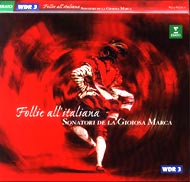 |
released 2001
total duration 60'23"
'Sonatori de la Gioiosa Marca' is an ensemble consisting of two violins (Giorgio Fava and Roberto Falcone), cello (Walter Vestidello), archlute and guitar (Giancarlo Rado) and harpsichord, spinet and organ (Gianpetro Rosato).
Follie all'italiana is the way for Sonatori to express how to perform these Italian pieces the italian way referring to the 5 folias included. If you are fond of the dances like the chaconne, passacaglia and folia, instrumental dances with ostinato basses which invites virtuoso improvisation and variation techniques from the 17th century in Italy this recording is hard to overlook. Besides the later Folias by Falconieri (at least in my idiom), Vivaldi and Reali, the early Folias by Storace (4'19" harpsichord solo) and Corbetta (2'11" 1671, guitar solo) are included. I presume they did not include the Folias by Corelli and Vitali deliberately because they picked from their repertoire some chaconnes and passacagli instead.
The delightful chaconnes and passacagli by not very well-known italian composers like Pandolfi (17th c.), Cazzati (1620-1677) and Caldara (1670-1736) are by no means breathing spaces but they rival the Folias easily. I can't deny that the passacaglia by Pandolfi (4'00") is the absolute highlight of this moving disc. The touching beauty of the sober basso continuo (organ and cello), the complaining violins with an occasional outburst in an attempt to break the perfect slow cadence will keep on echoing in your head.
This kind of repertoire is often arranged for an ensemble
including flutes which tends to be very dominant in my perception
breaking the delicate intimate spell of the plucked and bowed
instruments. Perhaps that flutes are inclined to drive up the tempo too.
I like this approach without flutes a lot and there is plenty of
virtuosity and depth to be heard. Another unorthodox attitude is to
build up almost every tune to a climax somehow. Not a
continuous repetition from the start till the end but sparing nuances
in dynamics, rhythm and instrumentation all contribute to add something
magical to the performances
best illustrated with the Folia by Falconiero (often referred to as
Falconieri).
The Folia by Reali, hardly recorded so far, is the concluded piece and
a finale where the listener can hear the young skillful enthusiasm of
Reali in a brilliant performance with a humorous wink to the flair for
dramatical effects in the pizzicato section, the very slow interlude
with the lute to build up the tempo and virtuosity towards the end.
- Falconiero
(Falconieri), Andrea (c.1585-1656)
- Title: Folias echa para mi Señora Doña Tarollila de Carallenos
- Performers: Fava and Falcone violin, Vestidello cello, Rado archlute and guitar, Rosato harpsichord
- Duration: 3'52"
- Recording date: June 11-14, 2000 Chiesa di S. Vigilio, Col San Martino Italy
- Reali,
Giovanni (c.1681-1751)
Sonatori de la Gioiosa Marca at You Tube in a live performance
Duration: 8'13" direct link to YouTube
© 2012 by Sonatori de la Gioiosa MarcasSonatori de la Gioiosa Marca at You Tube
Duration: 7'48" direct link to YouTube
© 2001 by Sonatori de la Gioiosa Marcas- Title: Folia from Suonate e Capricci op. I, Venezia 1709
- Performers: Fava and Falcone violin, Vestidello cello, Rado archlute and guitar, Rosato harpsichord
- Duration: 7'27"
- Recording date: June 11-14, 2000 Chiesa di S. Vigilio, Col San Martino Italy
- Vivaldi,
Antonio (1678-1741)
Sonatori de la Gioiosa Marca at You Tube
Duration: 9'02" direct link to YouTube
© 2001 by Sonatori de la Gioiosa Marcas- Title: Follia, sonate a tre op. 1 Venezia 1705
- Performers: Fava and Falcone violin, Vestidello cello, Rado archlute and guitar, Rosato harpsichord
- Duration: 8'54"
- Recording date: June 11-14, 2000 Chiesa di S. Vigilio, Col San Martino Italy
Christian Brembeck
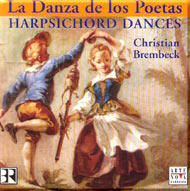 |
released 2002
total duration 63'37"
This recording which features three different harpsichords and a clavichord in dances stretching from Renaissance, Baroque, the Classic period to Romanticism contains three great Folias. It is almost inevitable to pick up some Folias with such a theme.
As Brembeck himself introduced La Folia in the slipcase (translation by Micheline Wiechert)
Incidentally, at this point in our anthology [Sanz] we make our first encounter with the 'Folia', which runs through our programme like a silver thread. The Folia (also Follia) is an eight-bar (in later forms also sixteen-bar) bass, which was first used in Spain in 1494 by Juan del Encina. The 'Follia di Spagna' subsequently developed into one of the most popular bases for variations (the most famous example is probably the sonata 'La Follia' by Arcangelo Corelli).
The oeuvre by Sanz is normally played on the rizzio guitar, but
Brembeck knows how to play these
jewels on a delicate clavichord. The sustain of the basses sounds
exceptionally well and the Folia by Sanz gets a new dimension this way.
High quality performances of the Folia-variations by Alessandro
Scarlatti and Carl Philipp Emanuel Bach. The only small omission is
that the documentation does not mention which instrument is used for
which track. I guess the performer assumes that we are all familiar
with early keyboard instruments and that the C.P.E. Bach Folia can only
performed on a copy by Hemsch like Picci's Ballet is made for the copy
by Ferrini.
It is of no importance considering the mid-price of this disc and the
deal that the famous Fandango by Soler and fantastic transcriptions of
Milan and de Falla are included to make it a bargain.
More about the oeuvre of Christian Brembeck at the website: http://www.christian-brembeck.de
- Bach, Carl
Philipp Emanuel (1714-1788)
- Title: 12 Variations on the 'Folie d'Espagne' Wq 118, 9 (1778)
- Performer: Brembeck, Christian (harpsichord)
- Duration: 8'00"
- Recording date: May 21-23, 2001, Studio 2, Bayerischer Rundfunk, Munich, Germany
- Sanz, Gaspar
(c.1645-c.1715)
- Title: Folia (1674)
- Performer: Brembeck, Christian (clavichord)
- Duration: 2'09"
- Recording date: May 21-23, 2001, Studio 2, Bayerischer Rundfunk, Munich, Germany
- Scarlatti, Alessandro (1660-1725)

-
Duration: 1'30", 2 Mb. (192kB/s, 44100 Hz)
6 Variations, featuring all different techniques on the harpsichord like the rich ornamentation (1), style brisé (2) and toccata (4)
© 2002 Christian Brembeck, used with permission- Title: Variazoni sulla 'Follia di Spagna' (1723)
- Performer: Brembeck, Christian (clavichord)
- Duration: 7'13"
- Recording date: May 21-23, 2001, Studio 2, Bayerischer Rundfunk, Munich, Germany
La Cetra d'Orfeo
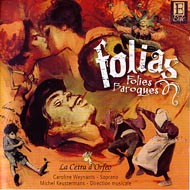 |
released 2007
total duration 77'30"
La Cetra d'Orfeo had definitely madness, the literal meaning of Folia, in mind when producing this disc
Of course the main theme is the musical Folia and there are almost half a dozen presented, but there is more to
desorient the listener. The variations by François Couperin of his 'Les Folies
françaises ou les Dominos'
for solo harpsichord are scattered separately as moments of refuge in between the up tempo tracks. Lots of functional percussion
quite similar built-in as Paniagua with his Folia disc, emphasizes the chaotic and energetic character of most tracks, even
in Vivaldi's Folia! And as a minor detail there is the information in the slipcase which is hardly readable with the small letters and coloured
backgrounds. There is no distinction made between the 'early' and 'later' Folia, as mentioned in the literature by
Richard Hudson but a new term the 'primitive' Folia is introduced to indicate the bass line of the 'later' Folia in Paggington's Pound.
Ok enough ingredients for a pleasant journey into madness to experience for more than an hour.
The Falconieri Folia, a piece for three, got a fresh arrangement where the voices are not distributed to the instruments from the start to the very
end. In the opening the violins tumble over each other while the recorders take over both parts while in the end in unison 2
recorders and the violin sign the peace treaty. It makes the piece a bit restless but it seems common practice in these
Falconieri-performances not to stick to the three initial instruments.
The Bach-piece is well sung indeed and the tempo is perfect to let the piece breath naturally. The distraction however
comes from the recorder which substitutes the violin part and you can hear that it take all efforts to get the low pitches on this instrument
especially at the ending.
The combination of Vivaldi's Folia and the recorder as lead instrument is quite naturalized nowadays but in my imagination Vivaldi should be
always associated with the violin. The percussion gives a nice 'folky' touch to the music
A first highlight of this disc is 'Paggington's Pound' (how many different spellings are there for indicating this
melody?). It will be my shortcoming that I only have heard instrumental versions of this piece, but as the Aria from
J.S. Bach it is extremely well sung.
However the overall highlight of the disc out of Folia-perspective is 'Poule Noire', a Wallon instrumental traditional which
got a nice arrangement, starting with the accordion solo in a virtuoso way and resulting in a real folk cracker with recorder
and drums, where the Folia melody is accompanied by a 16 bars 'answer' which makes the tune very original both from a
musical as instrumental perspective.
More about La Cetra d'Orfeo you can read at their homepage http://www.lacetra.com
Michel Keustermans wrote for the slipcase (translation by Rachel Stacchini-Betton-Foster):
With some daring we have taken the liberty of associating two stylistically different concepts
which in fact evoke the same idea: the Folia and the melodies of the Folia. Indeed, it is this concept that we
have used on the numerous occasions in concert much to the enjoyment of our audiences (so it seems) which has encouraged us to
present this disc, for the Folia is not only a dance, it is sometimes also sung
All sources agree that this form goes back to the Middle Ages, coming from popular tradition in the Iberian peninsular.
Its merry character was particularly suited to festive celebrations where there was dancing, sometimes to the point of madness.
In 1611 Covarruvias Horozco (Tesoro de la lengua castellana o española) explains that the dancing was so wild
and noisy that the dancers appeared to go into a trance (The New Grove Dictionary of Music and Musicians, vol. 6)
Mention is made in the literature of the time that it was sometimes even forbidden.
It was one of the 'standards' on which any musician worthy of the name could improvise an infinite number of variations,
just as our jazzmen do today with their standards from 'Real Book'. One finds a large number of outlines of this type
in the Renaissance built on a bass line of a few chords, repeated incessantly. Let us take, for example, the Passamezzo antico
(Stingo), the Passamento modern (Pagginton's Pound), the Romanesca (Greensleeves), the Bergamasca (cfr. our 'Kaleidoscope CD),
the Galliarda Napolitana (Valente), the Ciaconna (Falconieri) and the profusion of English grounds of which
Purcell became a phenomenal practitioner. To improvise on these bass lines was therefore common practice in the 16th Century, and
from a simple improvisation it was quite natural to progress to some masterpieces where musicians such as Diego Ortiz or Antonio
Valente are concerned. Many composers thus seized upon this form and more or less standardised it for writing variations.
Every period had, in some way, its own rules and style, and the diferencias ('diminutions' in Spanish) on a Folia from the 15th
Century (for example Ortiz) are far removed from the variations on a Folia by Carl Philipp Emmanuel Bach, going to the opposite extreme.
Of course, the harmonic and structural developments follow the same historical route. Between the two one finds composers such as Encina,
Martin Y Coll, Falconieri, Corelli, Vivaldi, Marais, and even Johann Sebastian Bach. In the 18th Century dance came to
the court in the form of the Sarabande, considerably slower in France (although we still find the expression 'a wild Sarabande'
because the English Sarabande seems to have kept its rapid tempo). Far from dying out, the form continued to be used in the 19th
Century by Cherubini, Liszt, Rachmaninov, and our compatriot Piet Swerts.
- Anonymous for keyboard, England (The Fitzwilliam Virginal Book)
- La Cetra d'Orfeo: Caroline Weynants (soprano), Michel Keustermans (recorder and director), Hervé Douchy (violoncelle), Jacques Willemijns (harpsichord), Jurgen De Bruyn (theorbo and baroque guitar), Stephan Pougin (percussion), Laura Pok (recorder), Ingrid Bourgeois (violon).
- Title: Paggington's Pound
- Released 2007 by EOLE compact disc EAD002
- Duration: 4'09"
- Recording date: May 2006 at Chapelle du Bois
- Edition John Playford published in the year 1651
- Bach, Johann Sebastian (1685-1750)

Duration: 1'03", 1 Mb. (128kB/s, 44100 Hz)
Fragment of the opening of Bach's Aria with a recorder substituting the voice of the violin
© 2007 La Cetra d'Orfeo, used with permission- La Cetra d'Orfeo: Caroline Weynants (soprano), Michel Keustermans (recorder and director), Hervé Douchy (violoncelle), Jacques Willemijns (harpsichord), Jurgen De Bruyn (theorbo and baroque guitar), Stephan Pougin (percussion), Laura Pok (recorder), Ingrid Bourgeois (violon).
- Title: Unser trefflicher lieber Kammerherr - folia extraite de la cantate BWV 212
- Released 2007 by EOLE compact disc EAD002
- Duration: 2'13"
- Recording date: May 2006 at Chapelle du Bois
- La Cetra d'Orfeo (ensemble)

Duration: 1'27", 1.4 Mb. (128kB/s, 44100 Hz)
Fragment of Poule Noir
© 2007 La Cetra d'Orfeo, used with permission- La Cetra d'Orfeo: Didier Laloy (diatonic accordion), Michel Keustermans (recorder and director), Hervé Douchy (violoncelle), Jacques Willemijns (harpsichord), Jurgen De Bruyn (theorbo and baroque guitar), Stephan Pougin (percussion), Laura Pok (recorder), Ingrid Bourgeois (violon).
- Title: Poule Noire (black hen), a Wallon taditional, unfortunately no sources mentioned for this tune
- Released 2007 by EOLE compact disc EAD002
- Duration: 3'25"
- Recording date: May 2006 at Chapelle du Bois
- Falconieri, Andrea (c.1585-1656)
- La Cetra d'Orfeo: Michel Keustermans (recorder and director), Hervé Douchy (violoncelle), Jacques Willemijns (harpsichord), Jurgen De Bruyn (theorbo and baroque guitar), Stephan Pougin (percussion), Laura Pok (recorder), Ingrid Bourgeois (violon)
- Title: Folias echa para mi Señora Doña Tarolilla de Carallenos
- Released 2007 by EOLE compact disc EAD002
- Duration: 3'43"
- Recording date: May 2006 at Chapelle du Bois
- Vivaldi, Antonio (1678-1741)

Duration: 1'48", 1.7 Mb. (128kB/s, 44100 Hz)
Fragment of the ending of Vivaldi's La Folia with percussion and recorders in the lead
© 2007 La Cetra d'Orfeo, used with permission- La Cetra d'Orfeo: Michel Keustermans (recorder and director), Hervé Douchy (violoncelle), Jacques Willemijns (harpsichord), Jurgen De Bruyn (theorbo and baroque guitar),
Stephan Pougin (percussion), Laura Pok (recorder), Ingrid Bourgeois (violon).
- Title: La Folia, op 1/12
- Released 2007 by EOLE compact disc EAD002
- Duration: 9'30"
- Recording date: May 2006 at Chapelle du Bois
- La Cetra d'Orfeo: Michel Keustermans (recorder and director), Hervé Douchy (violoncelle), Jacques Willemijns (harpsichord), Jurgen De Bruyn (theorbo and baroque guitar),
Stephan Pougin (percussion), Laura Pok (recorder), Ingrid Bourgeois (violon).
Lorenzo Cavasanti, Jorge Alberto Guerrero and Paolo Erdas
 |
released July 2004
total duration 76'22"
This disc is especially a treat for the listeners of virtuose recorder music.
Although 10 variations of Marais' Folies d'Espagne have been left out, as considered
not really suitable for the recorder (the missing variations are 6, 8, 11-14,
23, 25, 27, and 29) it definitely is the highlight of this recording.
Next to the Folies d'Espagne by Marais (originally for viola da gamba and b.c.)
the Follia by Corelli Op. 5 no. 12 is also arranged
for recorder instead of the usual violin as the leading part. The only disadvantage
I always encouter as a non-recorder-expert with these Corelli-recorder arrangements
is that the pitch of the instrument seems artificially too high to appreciate
the Follia to the full extend. I guess this is due to be able to get the range of all tones
required to play the piece with the original violin-melody.
Andrea Lausi wrote about recorder-music in general and in perspective of especially this compact disc (used with permission, 2005):
I have always considered the anthologies issued by the Brüggen-Bylsma-Leonhard
trio for Telefunken (Italian Recorder Sonatas, Blockflötenmusik auf Originalinstrumenten...)
among the key recordings of the ‘70s. Veritable chamber music lesson,
these recordings shaped the perception of the recorder as a musical instrument
for many years to come. What I find central to this is the quality, so-to-say
the real magic, of Brüggen’s sound. The recorder is an instrument with
a particular limited amount of overtones – it is actually a good approximation
to a sonic laser with all the energy concentrated in the fundamental –
and Brüggen’s playing puts this quality at the center of his constant
focus. A playing where the center of the tone is never missed, the sound being
always direct and full. These qualities blend with the play of other two musicians
in interpretations of a simple nobility, where the 'abstract' timbre of the
recorder – the quality Brüggen once defined as its 'dangerous innocence'
– appears perfectly functional in putting in evidence all of the curves
and shapes of the compositional architecture.
The Brüggen-Bylsma-Leonhard series included also a very impressive rendition
of the Follia and, given such an overwhelming example to confront with, I have
been always surprised that in the past years so many recorder players recorded
the piece, which after all is definitely not a piece composed originally for
the recorder.
Coming to the present recording, Corelli’s set of variation is actually
perfectly fitting the programmatic frame of ‘The Mirror Recomposed’
recital, and I find the Cavasanti-Guerrero-Erdas reading to be perhaps the first
to cope with the mastery of BBL example. Paola Erdas and Jorge Alberto Guerrero
support very effectively the soloist, carving the bass line with a present and
dedicated play which follows closely Cavasanti’s interpretation. At the
other side of this French-Italian mirror, Marais’ Couplets de Folies d'Espagne,
the center of gravity is shifted towards the two bass instruments: the harpsichord
– veritable driving force - and the cello’s necessary bow presence,
which actually seem to give the momentum. I find quite interesting the clarity
of the timbre separation allowed by the use of the recorder for the top line.
In my personal view this is the best piece of the CD, together with Couperin’s
La Tenebreuse and the Sonata by Vivaldi.
Gilles Cantagrel wrote for the slipcase (translation by Christopher Cartwright and Godwin Stewart):
So, to the very famous variations in trio on la Follia by Corelli, which open
the concert, the response in false symmetry at the very end will be the trio
of the Folies d'Espagne by Marin Marais, his exact contemporary the other side
of the Alps - two admirable pieces of equal length on the same motif, that Portuguese
dance of the folia which passed through Spain (whence the name 'Folies d'Espagne'
given to it by the French) and whose popularity soon swept throughout Europe
in the 17th century. Lully adopted the famous theme and d'Anglebert won fame
with his variations for harpsichord on the same subject. This is before one
finds it in Italy with the 23 variations from Corelli, and then again in France
from Marin Marais. Would extravagance itself not be a symbol of the Baroque,
a precious asset of the imaginary and a pretext for everything daring, for all
metamorphoses?
Always variations in fact. For, used as an ostinato bass, such a motif, insistent,
obsessional, lends itself admirably to this universe of multiplicity drawn from
the unique, which, since Sweelinck and Frescobaldi, was cultivated by the Baroque
in partitas, chaconnes and passacaglias. As support for extended developments,
displaying the imagination of the composer and the vivacity of the performer,
the variation is par excellence the technique of composition for this era, common
to Italy and France as to the whole of Europe. But the very concept of the variation
has its roots much further away than in the art of pleasing. Everything points
to how, as in the buildings of Borromini, it imposes the fantasy of ornamentation
on the rigour of the structure. And above all in what it proposes as a vision
of the world and the position of mankind therein. Comparing itself to the movements
of the planets, it cultivated the notion of the cycle at a time when modern
astronomy was emerging with Copernicus, Kepler and Galileo, when Harvey discovered
the circulation, that is to say the circle, of blood. And when, theorising about
Baroque thought, the philosopher Leibnitz could declare: 'My basic meditations
revolve around two things, to know about unity and about infinity. [...] Above
all, in fact, we are pleased by variety, but reduced to unity.' One could not
ask for a better definition of the variation.
- Corelli, Arcangelo (1653-1713)

Duration: 0'54", 848 kB. (128kB/s, 44100 Hz)
The opening of Opus 5 nr. 12 as played by Cavasanti, Guerrero and Erdas
© 2004 Cavasanti, Guerrero and Erdas, used with permission- Title: La Follia Op.5/12
- Performers: Cavasanti, Lorenzo (alt-flute in f), Guerrero, Jorge Alberto (cello), Erdas, Paola (harpsichord)
- Duration: 10'21"
- Recording date: August 8-10, 2002 in Montevarchi, Arezzo, Italy
- alto flute in f built by Luca de Paolis after P. Bressan (c.1710), cello built by Claude Pirot (end of 18th century), harpsichord built by Tony Chinnery (2002) after Carlo Grimaldi
- Marais, Marin (1656-1728)

Duration: 0'52", 820 kB. (128kB/s, 44100 Hz)
The ending of Les Folies d'Espagne as played by Cavasanti, Guerrero and Erdas
© 2004 Cavasanti, Guerrero and Erdas, used with permission- Title: Les Folies d'Espagne
- Performers: Cavasanti, Lorenzo (alt-flute in f), Guerrero, Jorge Alberto (cello), Erdas, Paola (harpsichord)
- Duration:10'55"
- Recording date: July 8-10, 2002 in Montevarchi, Arezzo, Italy
- alto flute in f built by Luca de Paolis after P. Bressan (c.1710), cello built by Claude Pirot (end of 18th century), harpsichord built by Augusto Bunza, Turbigo (1988) after J.H. Hemsch
Kurt Martinez (guitar)
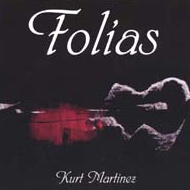 |
released 2003 (not indicated in the documentation)
total duration 48'37"
Documentation of the disc is poorly. The year of release, place and date of the recording all are missing and the duration of the pieces is not indicated.
It is rather striking because Kurt Martinez knows his stuff. In October 2004 he published a lengthy good in-depth article about the history of La Folia in guitar music published in Soundboard, the magazine of the Guitar Foundation of America with all references possible (well, except for this website).
- Dumond, Arnaud
(1952- )
- Title: Les Folies d'Espagne
- Released without indication of year (but it is 2003) by Kurt Martinez without order number
- Duration: 6'53"
- Recording date: not mentioned in the slipcase
- Fossa, François de
(1775-1849)
- Title: Les Folies d'Espagne
- Released without indication of year (but it is 2003) by Kurt Martinez without order number
- Duration: 6'34"
- Recording date: not mentioned in the slipcase
- Giuliani, Mauro (1781-1829)
- Title: Variazioni Sulla Follia
- Released without indication of year (but it is 2003) by Kurt Martinez without order number
- Duration: 5'49"
- Recording date: not mentioned in the slipcase
- Llobet, Miguel (1878-1939)
- Title: Variaciones de un Tema de Sor
- Released without indication of year (but it is 2003) by Kurt Martinez without order number
- Duration: 9'26"
- Recording date: not mentioned in the slipcase
- Sanz, Caspar (c.1640-c.1710)
- Title: Folias
- Released without indication of year (but it is 2003) by Kurt Martinez without order number
- Duration: 3'16"
- Recording date: not mentioned in the slipcase
- Sor, Fernando (1778-1839)
- Title: Les Folies d'Espagne
- Released without indication of year (but it is 2003) by Kurt Martinez without order number
- Duration: 4'48"
- Recording date: not mentioned in the slipcase
Various artists
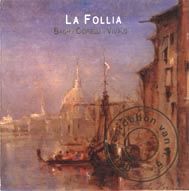 |
released 1994
total duration 70'09"
This recording, released by the friendly priced Erasmus-label, was introduced as a promotional cd for the label. Documentation is extremely poorly to cover up for the low price and there are all sorts of orchestras and Baroque-repertoire, like a trompet-concert by Albinoni and a mandoline-concert by Vivaldi.
The interesting part of this disc is that it contains two famous Folias. The Corelli-arrangement is the one for recorder, an arrangement of the Opus 5 nr. 12 for violin.
- Corelli,
Arcangelo (1653-1713)
- Title: La Follia (1702 arrangement for recorder)
- Performers: Pieter-Jan Belder (recorder), René Schiffer (viola Baroque) Herman Stinders (harpsichord)
- Duration: 11'05"
- Recording date: not indicated in the slipcase
- Vivaldi,
Antonio (1678-1741)
- Title: Triosonate in d RV 63 (Variaties op 'La Follia') (1705)
- Performers: Musica Petropolitana: Andrei Reshetin and Serguei Filtchenko (violin), Dmitri Sokolov (cello), Irina Shneyerova (harpsichord)
- Duration: 9'23"
- Recording date: not indicated in the slipcase
Jeanne Lamon/Tafelmusik Baroque Orchestra
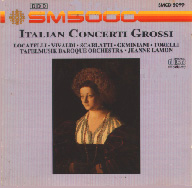 |
released 1991
total duration unknown
What can I say? Fantastic performances of two Folias at one disc. And a bit of a relief that the obvious choice of Corelli's Folia here is passed in favour of the Vivaldi- and the Geminiani-Folia. However since Geminiani was a student of Corelli the influence of Corelli is heard throughout because it is completely based upon the Corelli-piece in a concerto grosso arrangement.
- Geminiani,
Francesco (1687-1762)
- Title: Concerto Grosso No. 6 D minor 'La Follia' (1726)
- Performers: Tafelmusik Baroque Orchestra: Stephen Marvin (violin), Jeanne Lamon (violin), Christina Mahler (violoncelle), Paul O'Dette (lute), Charlotte Nediger (harpsichord)
- Duration: 9'13"
- Recording date: 1991(?) in St. Mary Magdalene Church, Toronto
- Vivaldi,
Antonio (1678-1741)
- Title: Trio sonata in d minor opus 1 No. 12 RV 63 'La Folia' (1705)
- Performers: Tafelmusik Baroque Orchestra: Stephen Marvin (first violin and ornamentation), Jeanne Lamon (violin), Christina Mahler (violoncelle), Charlotte Nediger (harpsichord)
- Duration: 9'36"
- Recording date: 1991(?) in St. Mary Magdalene Church, Toronto
|
Belladonna
Ten Thousend lakes' cd without ordernr. barcode 6 0197199032 3 released 1999 (not indicated in the slipcase or disc) total duration 63'35" |
Belladonna
compact disc 93228 released May 1, 2001 Re-release of barcode 6 0197199032 3 total duration 63'35" |
Who expects that behind the ambitious title of the recording 'Folias Festivas' a rich variety of careful selected Folias is hidden, will be disappointed: with more than a hundred different folias to pick from Belladonna only picked 6 early (Storace, Ortiz) and later Folias to complete the disc with 12 other (non-folia) compositions.
The early Folia by Storace, originally for harpsichord solo sounds great in an arrangement for the quartet including some nice pizzicato. Unfortunately the Folies d'Espagne by Marais has been abridged dramatically with a duration of less than 6 minutes. No Weltschmertz in these performances. It all sounds suspiciously lighthearted.
Barbara Weiss and Suzannae Mudge wrote for the slipcase (used with permission):
From the boisterous streetfestivals of fiftheenth-century Portugal to the refined entertainments of royal European courts, folias carried the spontaneous energy of popular music into the world of art music. These irresistible dance pieces, which were transmitted via the high-spirited strumming of the Spanish guitar, emboldened seventheenth-century composers to create exuberant and playful compositions of their own. The selections on this recording include folias from Spain, Italy and France, along with pieces built upon other ground-bass dances and those that incorporate dance rhythms in their structures. The first references to the folias in Spanish and Portuguese writings assume that the reader already knew what a folia was. Consequently, while we don't have the information to visualize a specific folia, we do know the word folias was associated with a poetic form, absurd lyrics, manic dance steps, a type of gathering, student entertainments, and the costumes and choreographies of cross-dressers. By the time the folia was defined as a particular chord progression in the seventheent century, it no longer encompassed the lyrics, dance steps and social situations of the earliest folia. Folias might have remained a local custom were it not for the rising popularity of the Spanish five-course guitar. Originally used for accompanying popular dances and songs and associated with barbers and other 'agents of idleness' this instrument captivated Europe in the 1600s and 1700s. It attracted 'the busiest of talented people' who 'put aside loftier occupations all for the guitar' which sounded well even if 'badly strung or played'. After beguiling (contemporaneous writers called it 'corrupting') the courts and chapels of Spain, the guitar found fertile ground in Spanish dominions in Italy and the New World. Italian influence was responsible, in turn, for broadcasting the guitar's popularity to French and English courts. Guitar music was published in Spain, Italy, France, England, the Netherlands and Germany until the mid-eighteenth century. Where the guitar went, so went its repertoire: folias and other dance-songs from public festivities in Spain, such as the chacona, jacara, and passacalles. Musicians throughout Europe exploited the improvisatory potential of these repeating basses; they ofered vehicles for personal expression and idiomatic displayes of virtuosity. Italian composers were among the first to use these harmonic and metric schemes as the basis for extended variation sets (Storace, Falconiero, Merula). Composers also integrated th rhythmic drive and phrase structures of popular dance in their tientos, sonatas, canzoni, recercadas, and fantasias (Ortiz, Tafalla, Castello, de Selma, Merula). Many of the composers represented on this recording were as mobile as the guitar. They further disseminated the repertoire and the approaches to composition the repertoire inspired. Ortiz worked in Naples, Cabanilles in France, Falconieri in Spain, Bertali and de Selma in Vienna, and Merula in Poland. In each locale, in every generation, these dance pieces were transformed by the musical needs and environment of musicians, never losing the vitality of their origins.
- Falconieri,
Andrea (1585-1656)
- Title: Folias echa para mi Señora Doña Tarolilla de Carallenos
- Performers: C. Galhano (recorder), M. Humphrey (baroque violin), R. Humphrey (baroque cello), B. Weiss (harpsichord)
- Duration: 2'51"
- Recording date: November 1998 at St. Bernard's Church in Saint Paul, Minnesota USA
- Marais, Marin
(1656-1728)
- Title: Folies d'Espagne (1701)
- Performers: C. Galhano (recorder), M. Humphrey (baroque violin), R. Humphrey (baroque cello), B. Weiss (harpsichord)
- arranged by C. Galhano
- Duration: 5'50"
- Recording date: November 1998 at St. Bernard's Church in Saint Paul, Minnesota USA
- Martin y
Coll, Antonio (?-after 1734)
- Title: Folias (1709)
- Performers: C. Galhano (recorder), M. Humphrey (baroque violin), R. Humphrey (baroque cello), B. Weiss (harpsichord)
- arranged by Barbara Weiss
- Duration: 2'09"
- Recording date: November 1998 at St. Bernard's Church in Saint Paul, Minnesota USA
